
The Wilhelm Gustloff as an Accommodation Liner
2nd U-Boat Training Division
1940 - 1945
2nd U-Boat Training Division
1940 - 1945
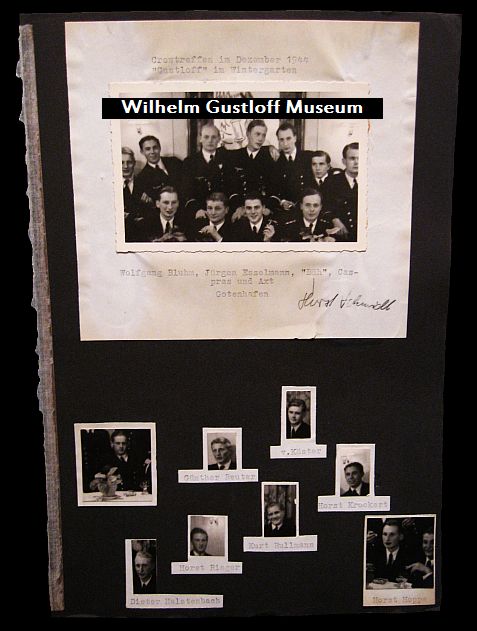
2.U.L.D.Crew photograph on board the accommodation ship Wilhelm Gustloff
December 1944.
Presented here is a one of a kind photograph of a crew meeting on board the Wilhelm Gustloff in her Wintergarden, dated December of 1944. During this time, she was accommodating U-boat crews in the Baltic port of Gotenhafen, which is present day Gdyna in Poland. What makes this photograph so interesting is that it was taken only one month before she was torpedoed and several of these men were aboard that fateful night!
*From the information we have, it is evident that these crew members all belonged to the 2nd U-Boat Training Division whose members were quartered aboard the Wilhelm Gustloff which served as a floating barracks at the time. These U-boat trainees received their practical training at sea on boats of the 22. Uboot-Flottille, also stationed at Gotenhafen, which was specifically formed as an Ausbildungsflottille. One of its Schulboote (training boats) was U-143 commanded by OLzS Walter Kasparek. In January 1945, before the arrival of the Red Army at Gotenhafen, 22.U-Fl. including U-143 was transferred to a port in the western Baltic (which one is not quite sure - Stettin, Swinemünde or Kiel perhaps.) It is an opinion that, with the exception of Kasparek, Bluhm and von Köster, the men on the photo, all eager young Leutnants zur See, were watch officer candidates going through the demanding lessons of preparing for duty on a Frontboot (boat on active war patrol).*
At the top of the album page is a complete crew photo with the heading "Crewtreffen im Dezember 1944, 'Gustloff' im Wintergarten." At the bottom of the photo is the caption, "Wolfgang Bluhm, Jurgen Esselmann, "Bah", Caspras und Axt. Gotenhafen." There is also a signature below the photograph which appears to be the name of "Hurst Schmidt" or "Hurst Schmidl."
A second photo was originally cut up into eight pieces according to person and their names typed underneath. They are listed below along with any information was found about each. A special thanks to Gert for helping to fill in the information on these crewmembers:
Wolfgang Bluhm: Served on the U-181 & U-143. Deceased 2005.
Jurgen Esselmann: Lt.z.S, Member of the 2nd U-Boat Training Division (2.U.L.D.), Survived the sinking.
Caspras: Nickname, OL.z.S. Walter Kasparek, Commander U-143.
Walker: Probable Lt.z.S, 2.U.L.D
Gunther Reuter: Lt.z.S. (Leutnant zur See or Ensign), U-3527
(Walter) v. Koster: If correct, Lt.z.S, destroyer Z-35, 6.Zerstörer-Flottille, Gotenhafen, which hit a mine and sank in the Eastern Baltic on December 12, 1944. This would mean the photo was taken in the first 11 days of the month.
Kurt Rullmann: Lt.z.S, 2.U.L.D - Lost with the ship. 1/30/45
Horst Krockert: Lt.z.S. U-930 (Commissioned on 12/6). As of 12/44, U-Flottille, Stettin, Ausbildungsboot. (Crew under training) Most likely transferred there from 2.U.L.D. Gotenhafen in early December.
Horst Hoppe: Not on a U-Boat, but survived the sinking.
Horst Riege: Probable Lt.z.S, 2.U.L.D
Dieter Halstenbach: Lt.z.S, 2.U.L.D., Wuppertaler, Survived the sinking and picked up by the torpedo boat TS 8/M375. Still living as of 10/29/08.
December 1944.
Presented here is a one of a kind photograph of a crew meeting on board the Wilhelm Gustloff in her Wintergarden, dated December of 1944. During this time, she was accommodating U-boat crews in the Baltic port of Gotenhafen, which is present day Gdyna in Poland. What makes this photograph so interesting is that it was taken only one month before she was torpedoed and several of these men were aboard that fateful night!
*From the information we have, it is evident that these crew members all belonged to the 2nd U-Boat Training Division whose members were quartered aboard the Wilhelm Gustloff which served as a floating barracks at the time. These U-boat trainees received their practical training at sea on boats of the 22. Uboot-Flottille, also stationed at Gotenhafen, which was specifically formed as an Ausbildungsflottille. One of its Schulboote (training boats) was U-143 commanded by OLzS Walter Kasparek. In January 1945, before the arrival of the Red Army at Gotenhafen, 22.U-Fl. including U-143 was transferred to a port in the western Baltic (which one is not quite sure - Stettin, Swinemünde or Kiel perhaps.) It is an opinion that, with the exception of Kasparek, Bluhm and von Köster, the men on the photo, all eager young Leutnants zur See, were watch officer candidates going through the demanding lessons of preparing for duty on a Frontboot (boat on active war patrol).*
At the top of the album page is a complete crew photo with the heading "Crewtreffen im Dezember 1944, 'Gustloff' im Wintergarten." At the bottom of the photo is the caption, "Wolfgang Bluhm, Jurgen Esselmann, "Bah", Caspras und Axt. Gotenhafen." There is also a signature below the photograph which appears to be the name of "Hurst Schmidt" or "Hurst Schmidl."
A second photo was originally cut up into eight pieces according to person and their names typed underneath. They are listed below along with any information was found about each. A special thanks to Gert for helping to fill in the information on these crewmembers:
Wolfgang Bluhm: Served on the U-181 & U-143. Deceased 2005.
Jurgen Esselmann: Lt.z.S, Member of the 2nd U-Boat Training Division (2.U.L.D.), Survived the sinking.
Caspras: Nickname, OL.z.S. Walter Kasparek, Commander U-143.
Walker: Probable Lt.z.S, 2.U.L.D
Gunther Reuter: Lt.z.S. (Leutnant zur See or Ensign), U-3527
(Walter) v. Koster: If correct, Lt.z.S, destroyer Z-35, 6.Zerstörer-Flottille, Gotenhafen, which hit a mine and sank in the Eastern Baltic on December 12, 1944. This would mean the photo was taken in the first 11 days of the month.
Kurt Rullmann: Lt.z.S, 2.U.L.D - Lost with the ship. 1/30/45
Horst Krockert: Lt.z.S. U-930 (Commissioned on 12/6). As of 12/44, U-Flottille, Stettin, Ausbildungsboot. (Crew under training) Most likely transferred there from 2.U.L.D. Gotenhafen in early December.
Horst Hoppe: Not on a U-Boat, but survived the sinking.
Horst Riege: Probable Lt.z.S, 2.U.L.D
Dieter Halstenbach: Lt.z.S, 2.U.L.D., Wuppertaler, Survived the sinking and picked up by the torpedo boat TS 8/M375. Still living as of 10/29/08.




Wilhelm Gustloff 2.U.L.D. Telegram - June 1944
949 Ingolstadt Do 1 22 16 1530
San Maat Georg Kratzer
7/2 U L D Gotenhafen Wilhelm Gustloff
Komme Samstag Zwischen 21 Und 23 Uhr in Gotenhafen an = Lydia ++
San Maat Georg Kratzer
7 / 2 U L D Gotenhafen Wilhelm Gustloff
Come Saturday between 21 and 23 clock in Gdynia on = Lydia + +
21 23 7 2 ++
949 Ingolstadt Do 1 22 16 1530
San Maat Georg Kratzer
7/2 U L D Gotenhafen Wilhelm Gustloff
Komme Samstag Zwischen 21 Und 23 Uhr in Gotenhafen an = Lydia ++
San Maat Georg Kratzer
7 / 2 U L D Gotenhafen Wilhelm Gustloff
Come Saturday between 21 and 23 clock in Gdynia on = Lydia + +
21 23 7 2 ++
Wilhelm Gustloff Accommodation Liner & U-Boat Training Photo Album - Medium Souvenir Album On board the U-708 - Gotenhafen & Danzig, December of 1942.
Souvenir Photos: 17 - Accommodation Liner / Training Photos: 96 = Total 113
Souvenir Photos: 17 - Accommodation Liner / Training Photos: 96 = Total 113
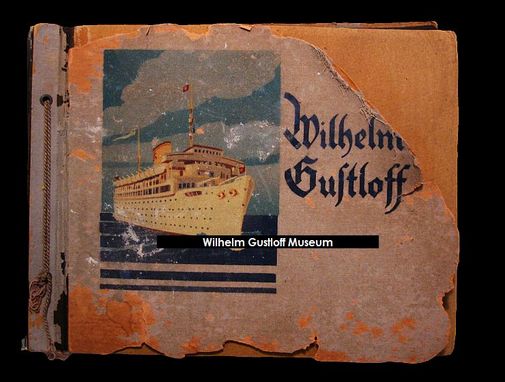
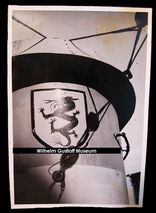
Presented here is a very unique photo album from the Wilhelm Gustloff of her days as an accommodation liner. The album shows severe damage after all these years and was seemingly kept with the sailor(s) aboard as it was being assembled. It features 12 souvenir photos of the Gustloff, 1 of the Robert Ley, 4 souvenir photos of Danzig, and 96 personal photos.
This album highlights the training of the U-708's crew during her time in Gotenhafen & Danzig. A type VIIC u-boat, she was completed July 24th, 1942 and entered training under the 8. Flottille with Oblt. Werner Heintze commanding her. "The officer on the bridge with the binoculars wearing the white hat is definitely the captain of the boat. Whether he is in fact OLzS Werner Heintze, commander of U-708, is open to question."
"U-708 was temporarily attached to 22. U.Flotilla from February of 1943 as a training boat while nominally still with 8 U-Fl. at Danzig." "For the remainder of the year, the U-708 was undergoing her own testing, training and acceptance trials and there were a number of bases that had to be visited to complete it." Gotenhafen was one of those bases.
A special thanks to u-boat author Dr. Nestle Axel, who quickly identified the U-708. It was known that she had a sea horse emblem during her time at sea, but the Chinese dragon emblem was shown during her time as a training u-boat. (The yellow stripe on the conning tower depicts she was in training.) Another photo of the U-708's emblem and damaged conning tower can be seen HERE. This damage resulted from a collision with a target vessel during the same month & year, causing minor crumpling.
Photo Album Sequence
After the souvenir photos, there are images of Kriegsmarine members in a bar, then of the same group training in the snows of Danzig. Afterwards, they board a train and arrive in port (probably Gotenhafen) and there are images around the area - and at one point, on board the General Osorio. (The photo in the cabin looks like the Gustloff, but perhaps it is the General Osorio.) The sailors mentioned in this album - Hans, Willi, & Walter -assembled it during their entire training, though not necessarily in order. The photo before the officers and crew on the U-708 is dated March of 1942 - 4 months before the U-708 was to be commissioned.
The album then shows the u-boat and its crew in formal attire for a ceremony of sorts. "The photos of the crew assembled on deck for some special ceremony clearly indicate that the boat was based at Danzig: The buildings seen in the background of these pictures are not congruent with the architectural silhouette of Gotenhafen but rather that of the city of Danzig." There are several photos of the u-boat crew's Christmas dinner on board what appears to be the Oceana and on board the U-708. "The pictures of the Christmas party suggest that the crew of U-708, having travelled by train from Danzig, were invited as a special treat to celebrate another Kriegsweihnacht (War Christmas) in the warm and cozy salons on board the Gustloff and other ships in Gotenhafen. (the quarters of the 8. U-Flottile at Danzig were not so cosy) with plenty of good food and drink."
All the remaining photos are of the u-boat crew training on board and of the captain and officers out on the water. There are a few snapshots around Gotenhafen's harbor featuring the Gustloff, Hamburg, Hansa, and another unknown ship. The album ends back on the u-boat with the crew doing everything from working the deck gun to peeling potatoes on the dock and cutting up fish on the u-boat's deck.
This album highlights the training of the U-708's crew during her time in Gotenhafen & Danzig. A type VIIC u-boat, she was completed July 24th, 1942 and entered training under the 8. Flottille with Oblt. Werner Heintze commanding her. "The officer on the bridge with the binoculars wearing the white hat is definitely the captain of the boat. Whether he is in fact OLzS Werner Heintze, commander of U-708, is open to question."
"U-708 was temporarily attached to 22. U.Flotilla from February of 1943 as a training boat while nominally still with 8 U-Fl. at Danzig." "For the remainder of the year, the U-708 was undergoing her own testing, training and acceptance trials and there were a number of bases that had to be visited to complete it." Gotenhafen was one of those bases.
A special thanks to u-boat author Dr. Nestle Axel, who quickly identified the U-708. It was known that she had a sea horse emblem during her time at sea, but the Chinese dragon emblem was shown during her time as a training u-boat. (The yellow stripe on the conning tower depicts she was in training.) Another photo of the U-708's emblem and damaged conning tower can be seen HERE. This damage resulted from a collision with a target vessel during the same month & year, causing minor crumpling.
Photo Album Sequence
After the souvenir photos, there are images of Kriegsmarine members in a bar, then of the same group training in the snows of Danzig. Afterwards, they board a train and arrive in port (probably Gotenhafen) and there are images around the area - and at one point, on board the General Osorio. (The photo in the cabin looks like the Gustloff, but perhaps it is the General Osorio.) The sailors mentioned in this album - Hans, Willi, & Walter -assembled it during their entire training, though not necessarily in order. The photo before the officers and crew on the U-708 is dated March of 1942 - 4 months before the U-708 was to be commissioned.
The album then shows the u-boat and its crew in formal attire for a ceremony of sorts. "The photos of the crew assembled on deck for some special ceremony clearly indicate that the boat was based at Danzig: The buildings seen in the background of these pictures are not congruent with the architectural silhouette of Gotenhafen but rather that of the city of Danzig." There are several photos of the u-boat crew's Christmas dinner on board what appears to be the Oceana and on board the U-708. "The pictures of the Christmas party suggest that the crew of U-708, having travelled by train from Danzig, were invited as a special treat to celebrate another Kriegsweihnacht (War Christmas) in the warm and cozy salons on board the Gustloff and other ships in Gotenhafen. (the quarters of the 8. U-Flottile at Danzig were not so cosy) with plenty of good food and drink."
All the remaining photos are of the u-boat crew training on board and of the captain and officers out on the water. There are a few snapshots around Gotenhafen's harbor featuring the Gustloff, Hamburg, Hansa, and another unknown ship. The album ends back on the u-boat with the crew doing everything from working the deck gun to peeling potatoes on the dock and cutting up fish on the u-boat's deck.
*Also highlighted in a red box on the dining room table is a Krupp-Berndorf silver coffee pot. This coffee pot is identical to the one removed from the Robert Ley on her home page on the site.
Above Right - After photographing the album, it was clear that most of the glue holding the photos was deteriorating to the point where the photos were simply falling off the pages. This blessing in disguise uncovered 4 photos in the album that have writing on the back.
Left to Right:
Photo #39: Gangdienst in Hamburg 3.42.
Corridor-Service in Hamburg.
Some kind of oversight / guard service on board.
Photo #80: Willi & Walter - Gotenhafen, Dez 42.
Photo #82: Willi: Meine Seele im Morgenrot. Translated: My soul in aurora. Gotenhafen 12.42.
Photo #84: Hans v Willi. Gotenhafen 12.42.
Photo #39: Gangdienst in Hamburg 3.42.
Corridor-Service in Hamburg.
Some kind of oversight / guard service on board.
Photo #80: Willi & Walter - Gotenhafen, Dez 42.
Photo #82: Willi: Meine Seele im Morgenrot. Translated: My soul in aurora. Gotenhafen 12.42.
Photo #84: Hans v Willi. Gotenhafen 12.42.
Of the officers in photograph #45 at the Christmas Party, I was told: From left to right:
The guy on the far left with both hands visible has the Iron Cross 2nd Class ribbon.
The guy next to him in the middle of Hitler’s picture has the Iron Cross 2nd Class ribbon and on his right hand side and a decoration I can’t identify. It could be a Spanish Cross or a German Cross. I am not sure which other decorations were worn on that side but there weren’t many. He also has another decoration on his left hand side but it could be any of 6 decorations I can think of. The guy on the far right with his eyes closed has the Minesweeper War Badge. It is also possible he is only a Petty Officer. The others are of course officers.
Once again, A special thanks to all of those who contributed to the story of this album. Quotes from the left have been taken directly from these forums to help tell the story. The full forums, as well as other research information on u-boats can be viewed at the following sites: ubootwaffe.net, ww2f.com, uboat.net, & u-historia.com.
The guy on the far left with both hands visible has the Iron Cross 2nd Class ribbon.
The guy next to him in the middle of Hitler’s picture has the Iron Cross 2nd Class ribbon and on his right hand side and a decoration I can’t identify. It could be a Spanish Cross or a German Cross. I am not sure which other decorations were worn on that side but there weren’t many. He also has another decoration on his left hand side but it could be any of 6 decorations I can think of. The guy on the far right with his eyes closed has the Minesweeper War Badge. It is also possible he is only a Petty Officer. The others are of course officers.
Once again, A special thanks to all of those who contributed to the story of this album. Quotes from the left have been taken directly from these forums to help tell the story. The full forums, as well as other research information on u-boats can be viewed at the following sites: ubootwaffe.net, ww2f.com, uboat.net, & u-historia.com.
Soup Bowl & Side Plate from on board the Wilhelm Gustloff
Taken off the ship in 1944 during her last few months afloat.
Bottom marked with the Nazi Eagle, M, KPM, 1941
Taken off the ship in 1944 during her last few months afloat.
Bottom marked with the Nazi Eagle, M, KPM, 1941
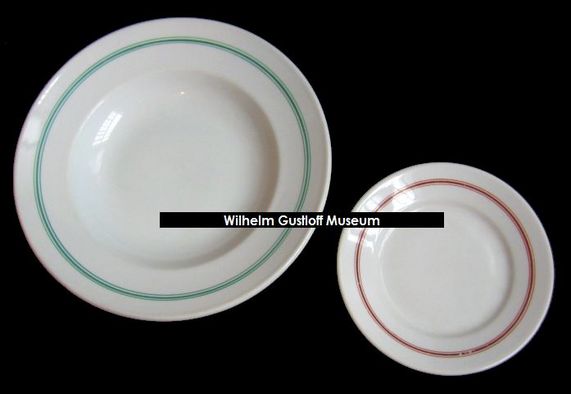
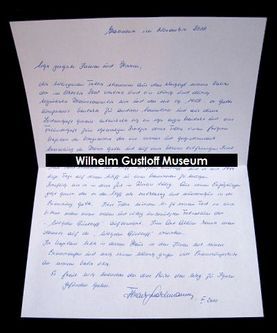
History by written letter:
The accompanying plates are from the estate of my father who passed away in October 2008 and he was a thoroughly enthusiastic marine collector and has been since about 1950. In Europe, he had developed contacts with other collectors and from this passion came to have a very close friendship with the former owner of these plates, a Kriegsmarine captain of a huge and exciting collection of marine artifacts who had lived on a small East Frisian island and died there several years ago.
"These plates are from the ship "Wilhelm Gustloff" and he was, in 1944, on board this ship for a few days to visit a comrade. Professionally, he worked in Berlin during this time. From his tales, he talked about these from the ship as he had a first class and wonderful memory. These plates were kept until his death in a display case next to a new and completely unused photo album of the Wilhelm Gustloff. This kind of album you could then purchase from the Wilhelm Gustloff. The captain lived in this house in the dunes with his memories and his desire for many recollection pieces went over to my father."
It is from his son which I purchased these plates in November of 2010.
The accompanying plates are from the estate of my father who passed away in October 2008 and he was a thoroughly enthusiastic marine collector and has been since about 1950. In Europe, he had developed contacts with other collectors and from this passion came to have a very close friendship with the former owner of these plates, a Kriegsmarine captain of a huge and exciting collection of marine artifacts who had lived on a small East Frisian island and died there several years ago.
"These plates are from the ship "Wilhelm Gustloff" and he was, in 1944, on board this ship for a few days to visit a comrade. Professionally, he worked in Berlin during this time. From his tales, he talked about these from the ship as he had a first class and wonderful memory. These plates were kept until his death in a display case next to a new and completely unused photo album of the Wilhelm Gustloff. This kind of album you could then purchase from the Wilhelm Gustloff. The captain lived in this house in the dunes with his memories and his desire for many recollection pieces went over to my father."
It is from his son which I purchased these plates in November of 2010.
Speisekarte Letter
Written on board ship, March 26th, 1942
Written on board ship, March 26th, 1942
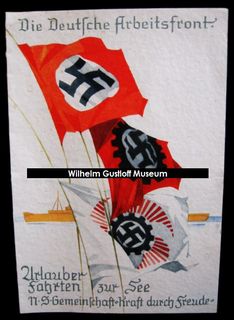
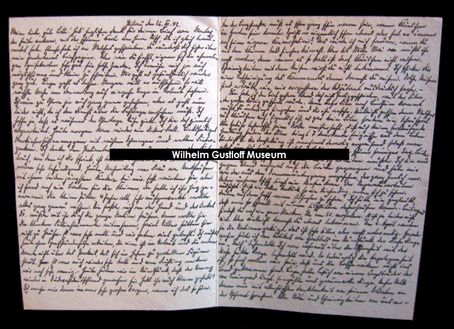
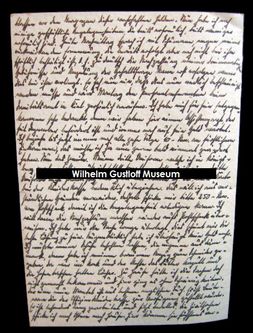
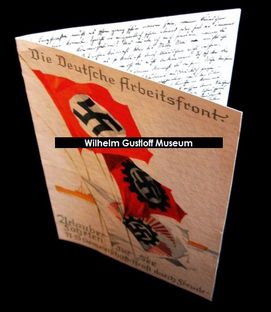

Knife and Fork from on board the Wilhelm Gustloff
Taken off during her time as an accommodation liner.
Taken off during her time as an accommodation liner.
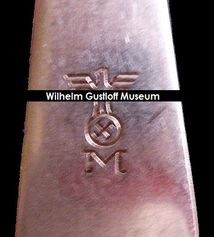
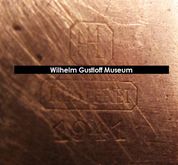
Here is a knife and fork that was taken off the Wilhelm Gustloff by one of her engineers during her time as an accommodation liner. The engineer, from Zwickau, Germany, nabbed them as souvenirs during the time and kept them along with a photo album and one of his boarding passes. When his effects were broken up some time later, a Gustloff collector purchased them and I through him. Stamped HL or HHL, Rostfrei. Knife dated 1941 and both pieces with the eagle on swastica and M.
Wilhelm Gustloff Small Souvenir Photo Album
Dated May 1942 out of Pillau - 33 total photos.
A very interesting photo album from wartime. The first few photos are what appear to be family vacation photos from a German family. Then there are four photos onboard the Type II U-62 out at sea. During May of 1942, she was a school boat based in Gotenhafen, so probably taken between the two cities in the Baltic. The remaining photos are of various Kriegsmarine members, and one outfit I am not familiar with.
There are two souvenir photos of the ship, but it is not the Wilhelm Gustloff, rather the Robert Ley. All the handwriting on the backs of the photos are the same person. Whether the sailor was on board both ships, or just one... one never knows.
Dated May 1942 out of Pillau - 33 total photos.
A very interesting photo album from wartime. The first few photos are what appear to be family vacation photos from a German family. Then there are four photos onboard the Type II U-62 out at sea. During May of 1942, she was a school boat based in Gotenhafen, so probably taken between the two cities in the Baltic. The remaining photos are of various Kriegsmarine members, and one outfit I am not familiar with.
There are two souvenir photos of the ship, but it is not the Wilhelm Gustloff, rather the Robert Ley. All the handwriting on the backs of the photos are the same person. Whether the sailor was on board both ships, or just one... one never knows.
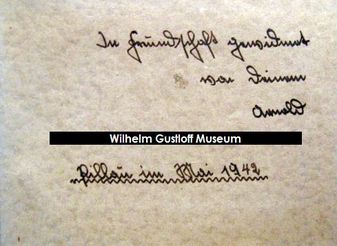
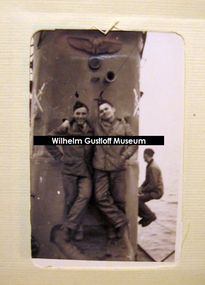

Wilhelm Gustloff Accommodation Liner & U-Boat Training Photo Album - Medium Album On board the U-841 - Gotenhafen & Kiel - 1942 & 1943.
Accommodation Liner / Training Photos: 58, Reprints: 23 = Total 81
Accommodation Liner / Training Photos: 58, Reprints: 23 = Total 81
Photo Captions: (by page) - I tried to read all the captions, but some are written so small and illegible, I wasn't able to get an accurate translation. If anyone can help, please email me.
1. Cover of the photo album.
2. U-841, 17.10.1943 (1917)
3. Being a recruit - Recruit
4. 2 U-Boat Training Division - Gotenhafen
5. The final training course. (on board the Wilhelm Gustloff.)
6. Diving with Danger, Swearing-in, Recruit.
7. My crew U-841 (XOE)
8. Front farewell with Admiral Donitz 01/03/42 (Kiel).
9. Into the Arctic Ocean by U-841, March to Norway, Look-out, Pik AS (Ace of Spades - Emblem on the U-841) in Bergen, Norway - 1943 11 flotilla, Names H. Welsch, H. Bohme, Snelle.
10. Escort "Bauec", Casting off lines, Surface shooting, A. Smarz & store, Fish, fish, fish, U-841 in the sea, Torpedo on the upperdeck.
11. Corporal "Hein", Private First Class 1942.
12. Officers U-841, OM Hedtfeld, OM Schwerin, IWO, IIWO (Office of the Watch) Lt. Haufmann, A good friend Lt. Huffman died 1943.
13. 1943 in Gdynia Hela - U-841, Kptlt. and Commander Bender U-841, Watch on bridge, 1943, In sea, in front of Greenland. Map quadrant - Possibly 07 U 919?
14. 1943 in Gdynia Hela - U-841
15. W. Snella died 1943, Snella, Rosenthal, Martin, Lt. z. See Huffman, Spare Second Watch, 3.7 cm gun, free watch.
16. Gun exercises, Excursion on "Hela", Recruit.
17. Ready for the tropics, Rosenthal, Snella, Voss, Martin, W. Snella, in the river delta Stettin June 1943 43rd, Officer of the Watch (Bootsmann?) Spark (Smoking) on deck, Atlantic.
18. U-Flak Course "MS Mars" Feb 1942, *** torpedoboat, East-Swinemünde 1942.
19. 2.ULD, W. Gustloff, Kptl. Stein - Representative of the 2nd Division.
20. W. Gustloff (Close-up of photo).
21. Holiday, December 1942.
22. Diver Course - Gotenhafen, 1942. (On board the Wilhelm Gustloff).
23. Sports after duty, beginners flag signaling.
24. Article on Heinz Taubert - Copy
25. Article on Heinz Taubert - Copy
26. Copy of diploma: Lower Saxony's minister for Science and Art. Heinz Taubert: His degree: University of Oldenburg Department of Maritime Studies in Elsfleth. Exam for Captain of open seas.
--- Reprints begin here in the album ---
27. 17/10/87 - Kiel - Laboe - Möltenort, The reunion after the years, 1987.
28. 1987 in Möltenort.
29. (Heinz Taubert) 1942, Onboard the U-841.
30. Bremen - Commissioning
31. Farewell to guest flotilla.
32. 1942 Kiel - Taking supplies, at attention.
33. Bremen 1942.
34. Bremen - 1942, Where to?
35. Lt. Th. Kiel
36. Farewell in Bremen, 1942.
37. Trip from the shipyard.
38. 1942.
39. Oct 1989 - A trip on the Danube Oct 1989.
1. Cover of the photo album.
2. U-841, 17.10.1943 (1917)
3. Being a recruit - Recruit
4. 2 U-Boat Training Division - Gotenhafen
5. The final training course. (on board the Wilhelm Gustloff.)
6. Diving with Danger, Swearing-in, Recruit.
7. My crew U-841 (XOE)
8. Front farewell with Admiral Donitz 01/03/42 (Kiel).
9. Into the Arctic Ocean by U-841, March to Norway, Look-out, Pik AS (Ace of Spades - Emblem on the U-841) in Bergen, Norway - 1943 11 flotilla, Names H. Welsch, H. Bohme, Snelle.
10. Escort "Bauec", Casting off lines, Surface shooting, A. Smarz & store, Fish, fish, fish, U-841 in the sea, Torpedo on the upperdeck.
11. Corporal "Hein", Private First Class 1942.
12. Officers U-841, OM Hedtfeld, OM Schwerin, IWO, IIWO (Office of the Watch) Lt. Haufmann, A good friend Lt. Huffman died 1943.
13. 1943 in Gdynia Hela - U-841, Kptlt. and Commander Bender U-841, Watch on bridge, 1943, In sea, in front of Greenland. Map quadrant - Possibly 07 U 919?
14. 1943 in Gdynia Hela - U-841
15. W. Snella died 1943, Snella, Rosenthal, Martin, Lt. z. See Huffman, Spare Second Watch, 3.7 cm gun, free watch.
16. Gun exercises, Excursion on "Hela", Recruit.
17. Ready for the tropics, Rosenthal, Snella, Voss, Martin, W. Snella, in the river delta Stettin June 1943 43rd, Officer of the Watch (Bootsmann?) Spark (Smoking) on deck, Atlantic.
18. U-Flak Course "MS Mars" Feb 1942, *** torpedoboat, East-Swinemünde 1942.
19. 2.ULD, W. Gustloff, Kptl. Stein - Representative of the 2nd Division.
20. W. Gustloff (Close-up of photo).
21. Holiday, December 1942.
22. Diver Course - Gotenhafen, 1942. (On board the Wilhelm Gustloff).
23. Sports after duty, beginners flag signaling.
24. Article on Heinz Taubert - Copy
25. Article on Heinz Taubert - Copy
26. Copy of diploma: Lower Saxony's minister for Science and Art. Heinz Taubert: His degree: University of Oldenburg Department of Maritime Studies in Elsfleth. Exam for Captain of open seas.
--- Reprints begin here in the album ---
27. 17/10/87 - Kiel - Laboe - Möltenort, The reunion after the years, 1987.
28. 1987 in Möltenort.
29. (Heinz Taubert) 1942, Onboard the U-841.
30. Bremen - Commissioning
31. Farewell to guest flotilla.
32. 1942 Kiel - Taking supplies, at attention.
33. Bremen 1942.
34. Bremen - 1942, Where to?
35. Lt. Th. Kiel
36. Farewell in Bremen, 1942.
37. Trip from the shipyard.
38. 1942.
39. Oct 1989 - A trip on the Danube Oct 1989.
Presented here is a very unique photo album from the U-841 and her training days. The U-841 was launched October 21st, 1942 as a Type IXC/40 under the command of Capt. Werner Bender. She operated as a training and front boat in 1943 for the 2nd and 4th Flotillas and never sank any enemy ships. On October 17th, 1943, she was sunk in the North Atlantic east of Cape Farewell, Greenland, in position 59.57N, 31.06W, by depth charges from the British frigate HMS Byard. There were 27 sailors who perished on board and 27 survivors. This photo album belonged to one of those survivors, Heinz Taubert (MtrGfr), and the person selling this also sold 3 other photo albums, as well as Mr. Taubert's uniform from the war. The album begins with a memorial photo for the U-841, and consists of several photos on board the u-boat and onboard the Wilhelm Gustloff for training and diving practice.
A few things make this album interesting - first, it's obvious Mr. Taubert took his photos from other albums and combined them all to this one to make a complete record. He hand-wrote comments for every photo in the album and the names of the crew he served with. The first half of the album are original photographs, and the last half are reprints or memorial photos. There are also photos of the sailors practicing in the dive tanks aboard the Gustloff. I have also seen another exact set (with more photos) of this training, backmarked with the 2 U.L.D. stamp. Even the one photo of the men standing at the stern of the Gustloff is an exact double, as I have another I purchased a year earlier. For historical records, I posted the other album (not in my possession) below this one.
Finally, here is a listing of the sailors shown in this album and their status after the sinking of the U-841. Statistics courtesy of www.ubootwaffe.net.
Crew of the U-841 featured in this album:
Bender, Werner - KpLt. - Born 28.10.1916 - U-841+ Cdr. 06.02.43 - lost E.of cape Farewell. 59.57N. 31.06W. 17.10.43.
Böhme, Heinz - FkOGfr - U-841. Pow.17.10.43
Hedtfeld, Wilhelm - OMasch - Born 15.10.1917 - U-841+ lost E.of Cape Farewell 17.10.1943
Huffmann, Ernst - Lt.z.S - Born 06.06.1923 - U-841+ died in shooting 15.09.1943
Martin, Erhard - U-841. U-1010
Rosenthal, Kurt - MtrGfr - Born 24.05.1925 - U-841+ lost E.of Cape Farewell 17.10.1943
Schwerin, Gerhard - OMasch - U-841. Pow.17.10.43
Smarz, Albin - MtrGfr - U-841. Pow.17.10.43 - Died 1.10.2004
Snella, Werner - MtrGfr - Born 24.07.1924 - U-841+ lost E.of Cape Farewell 17.10.1943
Taubert, Heinz - MtrGfr - U-841. Pow.17.10.43
Voss, Franz-Peter - MtrGfr - U-841. Pow.17.10.43
Welsch, Horst - MtrOGfr - Born 27.03.1924 - 841+ lost E.of Cape Farewell 17.10.1943.
A few things make this album interesting - first, it's obvious Mr. Taubert took his photos from other albums and combined them all to this one to make a complete record. He hand-wrote comments for every photo in the album and the names of the crew he served with. The first half of the album are original photographs, and the last half are reprints or memorial photos. There are also photos of the sailors practicing in the dive tanks aboard the Gustloff. I have also seen another exact set (with more photos) of this training, backmarked with the 2 U.L.D. stamp. Even the one photo of the men standing at the stern of the Gustloff is an exact double, as I have another I purchased a year earlier. For historical records, I posted the other album (not in my possession) below this one.
Finally, here is a listing of the sailors shown in this album and their status after the sinking of the U-841. Statistics courtesy of www.ubootwaffe.net.
Crew of the U-841 featured in this album:
Bender, Werner - KpLt. - Born 28.10.1916 - U-841+ Cdr. 06.02.43 - lost E.of cape Farewell. 59.57N. 31.06W. 17.10.43.
Böhme, Heinz - FkOGfr - U-841. Pow.17.10.43
Hedtfeld, Wilhelm - OMasch - Born 15.10.1917 - U-841+ lost E.of Cape Farewell 17.10.1943
Huffmann, Ernst - Lt.z.S - Born 06.06.1923 - U-841+ died in shooting 15.09.1943
Martin, Erhard - U-841. U-1010
Rosenthal, Kurt - MtrGfr - Born 24.05.1925 - U-841+ lost E.of Cape Farewell 17.10.1943
Schwerin, Gerhard - OMasch - U-841. Pow.17.10.43
Smarz, Albin - MtrGfr - U-841. Pow.17.10.43 - Died 1.10.2004
Snella, Werner - MtrGfr - Born 24.07.1924 - U-841+ lost E.of Cape Farewell 17.10.1943
Taubert, Heinz - MtrGfr - U-841. Pow.17.10.43
Voss, Franz-Peter - MtrGfr - U-841. Pow.17.10.43
Welsch, Horst - MtrOGfr - Born 27.03.1924 - 841+ lost E.of Cape Farewell 17.10.1943.
Wilhelm Gustloff Gotenhafen Training Album - 1942/43
Photos - 34. European Auction.
I have seen this album for sale, sold, then resold again. While I didn't obtain it, I saved all of the photos for historical record. I am posting them to show because they go with several of the diving photos in the album above. The Kriegsmarine, or someone else, must have made copies to show for training purposes since they are identical. I eventually gained a few examples in other albums that I've come across.
Photos - 34. European Auction.
I have seen this album for sale, sold, then resold again. While I didn't obtain it, I saved all of the photos for historical record. I am posting them to show because they go with several of the diving photos in the album above. The Kriegsmarine, or someone else, must have made copies to show for training purposes since they are identical. I eventually gained a few examples in other albums that I've come across.
Wilhelm Gustloff Small Souvenir Album
Photographs: 41
Inside Cover: Handwritten:
Seaman Herbert L. was in Gotenhafen from Nov 15th to Jan, 1942 with the 2 U.L.D. on the KdF ship Wilhelm Gustloff
Other inside cover :
In permanent memory to my members of my u-boat training.
Photographs: 41
Inside Cover: Handwritten:
Seaman Herbert L. was in Gotenhafen from Nov 15th to Jan, 1942 with the 2 U.L.D. on the KdF ship Wilhelm Gustloff
Other inside cover :
In permanent memory to my members of my u-boat training.
Very unusual find showing one of the sailors on board using a blank Triple Nazi Flag menu cover and inside as a creative letter from the accommodation ship. There were probably a few lying around after the ship's printing presses were shut off in 1939. Believed to have come from the Wilhelm Gustloff, though with the sentence "Next to our ship is a huge ship", it is possible this could have been written on the Oceana or Hansa. Translation (opposite) courtesy of Werner Hinke.
Synopsis of letter: March 26th, 1942
My dear Lothar, Thank you for your letter from Monday, you may be wondering about my strange paper, but these cards serve the purpose. I will write in a small script. I am doing quite well.. XX is doing better, he will get out of bed tomorrow. He wants to take some vacation time next week. I hope that things will be quiet over the Easter week. I am really exhausted. This morning was difficult. I woke up with pain in my upper jaw and a high fever. The broken jaw that I wrote about has healed well. The x-rays look good.
This afternoon , Mrs. Xxx with her two young children came to visit. I did have a few sweets. Little Jutta, 4 years old, very active, wanted to know everything. We had many laughs. I had to work without the two receptionists, one is on vacation the other one is sick. On the Bergstrasse it is quite warm. Do you already know when you will come? I would be very glad if you get here with the small ones. But I will have to wait until mid-May. Do not worry about the tires, I will get a confirmation from the commanding officer. Such tires can be found as the assistant to the officer explained. I did not finish last night as I went to see the film – The Great King (film shown in 1942). Otto Gebühr played it very well. It really is not a film but a piece of theatre. It deals with the life of Friedrich II. The presentation really grabs you. I spent the evening on the bridge and looked at the sunset, that was magnificent.
Next to our ship is a huge ship. It is quite a sight to see such a big one next to you. I would have never thought that one can move with that size. Enclosed you find some ration stamps that are valid until the 31st. It is not much. But maybe you can get something. On April 6, they will cut the rations, that is very bitter, but necessary. I just heard the article by Goebbels on the radio that talks about these things of the war. I was glad about the openness with which they touch these dark questions. Difficult as it is we only want that the Bolsheviks do not come into the country….. who lies in front of Leningrad. They only talk about cruel things. Now I have a few business matters. Some more formal, others not. The putting into order my question of salary can only proceed if notarized, and I have to go to Kiel to get the personal information. But we know of a case of an officer who was promoted in December and is still waiting for his money. I think I may get 10 Rm more in my splendid income, My third uniform had been made in Königsberg, I paid for it.
Please send me 250 RM so that I do not have to overdraw my account, so that I can settle the matter. I have thought about it, and this seems to be the best. At the moment I do not have any money. I still have my brown suit. (He is expecting an overcoat from the officer's mess, one that is made especially long and that fits very well). *The remainder of the letter was too difficult to translate.
Synopsis of letter: March 26th, 1942
My dear Lothar, Thank you for your letter from Monday, you may be wondering about my strange paper, but these cards serve the purpose. I will write in a small script. I am doing quite well.. XX is doing better, he will get out of bed tomorrow. He wants to take some vacation time next week. I hope that things will be quiet over the Easter week. I am really exhausted. This morning was difficult. I woke up with pain in my upper jaw and a high fever. The broken jaw that I wrote about has healed well. The x-rays look good.
This afternoon , Mrs. Xxx with her two young children came to visit. I did have a few sweets. Little Jutta, 4 years old, very active, wanted to know everything. We had many laughs. I had to work without the two receptionists, one is on vacation the other one is sick. On the Bergstrasse it is quite warm. Do you already know when you will come? I would be very glad if you get here with the small ones. But I will have to wait until mid-May. Do not worry about the tires, I will get a confirmation from the commanding officer. Such tires can be found as the assistant to the officer explained. I did not finish last night as I went to see the film – The Great King (film shown in 1942). Otto Gebühr played it very well. It really is not a film but a piece of theatre. It deals with the life of Friedrich II. The presentation really grabs you. I spent the evening on the bridge and looked at the sunset, that was magnificent.
Next to our ship is a huge ship. It is quite a sight to see such a big one next to you. I would have never thought that one can move with that size. Enclosed you find some ration stamps that are valid until the 31st. It is not much. But maybe you can get something. On April 6, they will cut the rations, that is very bitter, but necessary. I just heard the article by Goebbels on the radio that talks about these things of the war. I was glad about the openness with which they touch these dark questions. Difficult as it is we only want that the Bolsheviks do not come into the country….. who lies in front of Leningrad. They only talk about cruel things. Now I have a few business matters. Some more formal, others not. The putting into order my question of salary can only proceed if notarized, and I have to go to Kiel to get the personal information. But we know of a case of an officer who was promoted in December and is still waiting for his money. I think I may get 10 Rm more in my splendid income, My third uniform had been made in Königsberg, I paid for it.
Please send me 250 RM so that I do not have to overdraw my account, so that I can settle the matter. I have thought about it, and this seems to be the best. At the moment I do not have any money. I still have my brown suit. (He is expecting an overcoat from the officer's mess, one that is made especially long and that fits very well). *The remainder of the letter was too difficult to translate.
Lot of World War II Sweetheart Letters - 1942 to 1944
Erika Garth's collection of 156 letters written to her sailor sweetheart Reinhold Schlott as he goes through his u-boat training during the war. Of these, 5 were typed and easily translated. The set also includes 7 undated pieces and two letters from 1951. One of these letters is translated below. The letters begin on
October 6th, 1942 addressed to:
5/19 Schiffstammabteilung (Ship Home Dept.)
Arsweiler ü Diedenhofen
Stube 48 (WestMark)
On January 4th, 1943 the address changes to:
5/1 U-Ausbildungsabteilung (U-Boat Education Dept)
Plön Holstein
On February 19th the address changes to:
2 Abt. Marineschule 4 Komp.
Kiel-Wik Stube 82
On March 31st, they go back to Plön Holstein
On April 24th, the address changes to:
2/4 U.L.D. Gotenhafen
2 Zug, 1 Gruppe
From June 15th to July 2nd, 1943 there are 11 letters addressed to Reinhold onboard the
Wilhelm Gustloff, 4/2 U.L.D. Gotenhafen.
On July 2nd, another letter is addressed to:
Neustordt (Holstein)
On September 9th, the address changes to:
Feldpost #M47587
On October 18th, the address changes to:
1/2/ U.A.A., (23) Gotenstedt ü Bremen
There is a break in the writing and the last few letters are dated between September 9th and October 23rd, 1944.
3/I.U.A.A. Neustadt (Holstein)
1/2/ U.A.A. Gotenstedt.
Erika Garth's collection of 156 letters written to her sailor sweetheart Reinhold Schlott as he goes through his u-boat training during the war. Of these, 5 were typed and easily translated. The set also includes 7 undated pieces and two letters from 1951. One of these letters is translated below. The letters begin on
October 6th, 1942 addressed to:
5/19 Schiffstammabteilung (Ship Home Dept.)
Arsweiler ü Diedenhofen
Stube 48 (WestMark)
On January 4th, 1943 the address changes to:
5/1 U-Ausbildungsabteilung (U-Boat Education Dept)
Plön Holstein
On February 19th the address changes to:
2 Abt. Marineschule 4 Komp.
Kiel-Wik Stube 82
On March 31st, they go back to Plön Holstein
On April 24th, the address changes to:
2/4 U.L.D. Gotenhafen
2 Zug, 1 Gruppe
From June 15th to July 2nd, 1943 there are 11 letters addressed to Reinhold onboard the
Wilhelm Gustloff, 4/2 U.L.D. Gotenhafen.
On July 2nd, another letter is addressed to:
Neustordt (Holstein)
On September 9th, the address changes to:
Feldpost #M47587
On October 18th, the address changes to:
1/2/ U.A.A., (23) Gotenstedt ü Bremen
There is a break in the writing and the last few letters are dated between September 9th and October 23rd, 1944.
3/I.U.A.A. Neustadt (Holstein)
1/2/ U.A.A. Gotenstedt.
Sample Letter: March 3rd, 1943:
Grävenwiesbach 21.3.43
My dear, good, faithful Reinhold!
Another gloomy Sunday comes to an end, over and over again one day closer to the long-awaited holiday. Soon, it will become a reality. Today I was not even outside the door. I was in bed this morning until 11 clock,.Then I did a little, then washed up just to get ready to go back to bed. I was up at 3 clock. So I did not yet notice it was Sunday, and the problem is, you're not here. Everything makes no sense. If you're merely over there, then that is something completely different. You just have to have patience - yes. Once the war comes to an end. Hopefully soon. But we must trust our beloved leader not to lose, then everything will go twice as well. It's all over everything. Now it is already 9 o'clock. Soon, it's back to bed. What have you done with my Schatzi today? (Assumed to be her pet goldfish which is discussed in other letters.) Although he was as lonely as I, without any entertainment. Say, Isn't your friend Walter still in Kiel, or is his time already up there? What there has not been on the act with an iron? Oh, I've seen a sailor today, although he was already an officer. I can say the very jagged. He had his girl with him, so very big. Oh my darling, I had such nice dreams last night if that would be merely one fact. The speech of the Führer was just transmitted again. He has taken a break from the holiday today.... I am lazy and tired and what not. Yes, I need to write bills, but I do not feel like it. You need to come home not merely on vacation soon, or I shall die of homesickness. Yes, yes, a sailor girl is to be all very well and good, only that the favorite is not there, that's bad luck. Now I know nothing more, everything else is anyway Plötsinn. For now closing my good Schatzi until tomorrow.
Greetings and kisses from the 100 trillionth !!!
Yours and only yours,
Erika!
Grävenwiesbach 21.3.43
My dear, good, faithful Reinhold!
Another gloomy Sunday comes to an end, over and over again one day closer to the long-awaited holiday. Soon, it will become a reality. Today I was not even outside the door. I was in bed this morning until 11 clock,.Then I did a little, then washed up just to get ready to go back to bed. I was up at 3 clock. So I did not yet notice it was Sunday, and the problem is, you're not here. Everything makes no sense. If you're merely over there, then that is something completely different. You just have to have patience - yes. Once the war comes to an end. Hopefully soon. But we must trust our beloved leader not to lose, then everything will go twice as well. It's all over everything. Now it is already 9 o'clock. Soon, it's back to bed. What have you done with my Schatzi today? (Assumed to be her pet goldfish which is discussed in other letters.) Although he was as lonely as I, without any entertainment. Say, Isn't your friend Walter still in Kiel, or is his time already up there? What there has not been on the act with an iron? Oh, I've seen a sailor today, although he was already an officer. I can say the very jagged. He had his girl with him, so very big. Oh my darling, I had such nice dreams last night if that would be merely one fact. The speech of the Führer was just transmitted again. He has taken a break from the holiday today.... I am lazy and tired and what not. Yes, I need to write bills, but I do not feel like it. You need to come home not merely on vacation soon, or I shall die of homesickness. Yes, yes, a sailor girl is to be all very well and good, only that the favorite is not there, that's bad luck. Now I know nothing more, everything else is anyway Plötsinn. For now closing my good Schatzi until tomorrow.
Greetings and kisses from the 100 trillionth !!!
Yours and only yours,
Erika!
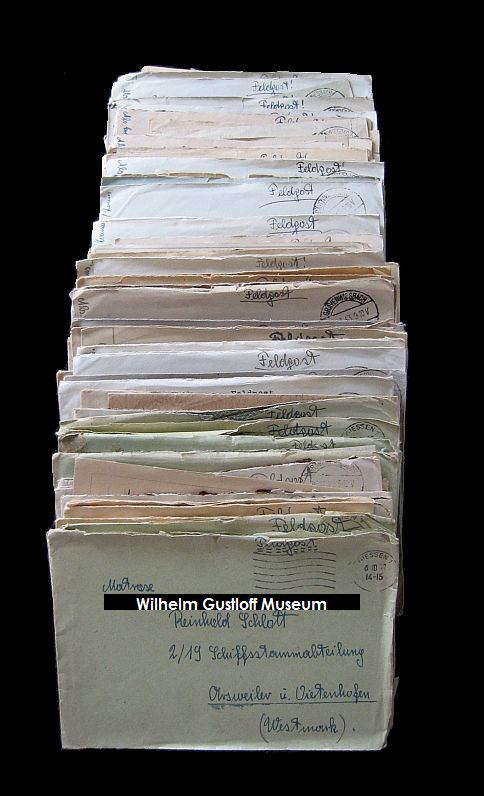
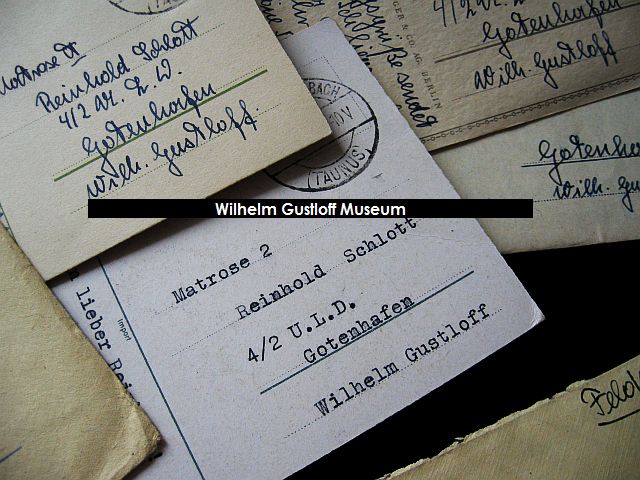
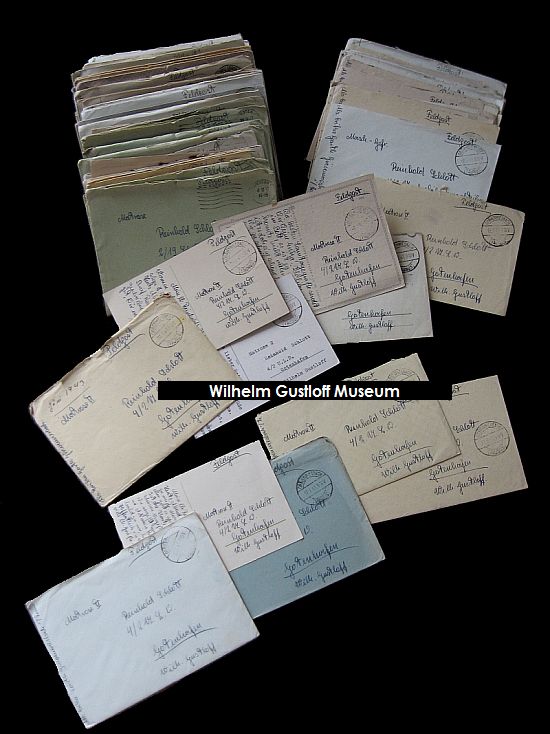
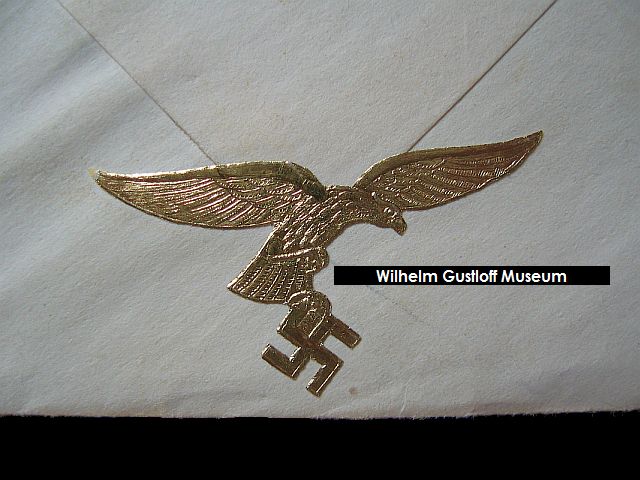
On November 20th, the Wilhelm Gustloff ties up in the Polish port of Gotenhafen (present day Gdynia). Admiral Karl Dönitz was ramping up his u-boat war in the Atlantic Ocean, sinking Allied shipping in large numbers. The u-boat campaign during 1940 was known as Die Glückliche Zeit, or the Happy Time. Just in the 5 months prior, over 270 Allied ships were sunk. With shipping losses mounting on the Allied side, the Axis were producing additional u-boats at a fast pace.
On November 2nd, the first of a new class of u-boat was commissioned - the Type VIIC U-69. Soon, one Type VIIC u-boat would turn into 568 being commissioned before the war's end. This, no doubt, played a major part in the need for men to operate these new submarines and the Wilhelm Gustloff would help train them. The 2. Unterseeboots-Lehrdivision, 2 U.L.D. or 2nd Submarine Training Division was formed in Gotenhafen, November 1940 and operated until January 1945. Its purpose was to train young cadets to operate the new u-boats as they were being commissioned. The 1,000 u-boat sailors would arrive in Gotenhafen where they would be housed on the Wilhelm Gustloff. Another passenger liner, the Hansa, would be berthed in front of the Wilhelm Gustloff and also be used to train the 2 U.L.D. and the 8th U-Boat Flotilla. The KdF liner Oceana was docked behind the Gustloff and used for the same purposes. The cadets training took place on board the ships, on land, and in the training u-boats that arrived in the harbor. The Wilhelm Gustloff had to undergo another conversion - this time from hospital ship to training ship.
Many of her hospital beds and equipment were removed, though the medical wards remained much as they were throughout her life. Much of the inside of the ship is gutted, some areas returned to her pre-war days to receive cadets, others remain for those who may be injured during training or emptied to use as practice space. Many of the doctors, nurses, and medics are gone - discharged or reassigned.
One of the largest items necessary for the 2 U.L.D. was a diving tank for training submariners to escape damaged u-boats, practice safety drills, etc. A large tank was set up for this purpose, most likely in one of the warehouse buildings alongside the ship. With her lines tied up and her engines shut off, this slip in Gotenhafen would become her home for the next 4 years, 2 months. Soon, her hospital markings would be removed and the Wilhelm Gustloff would go back to the white passenger liner she once was. She would remain white for the next few months until the winter had passed. The final part of her conversion would be a coat of naval gray paint from stem to stern to camouflage her size and appearance while berthed. For the first time, the Wilhelm Gustloff was no longer protected under her hospital ship status. The red crosses are removed on her funnel, leaving barely visible raised imprints of colorless KdF logos. She was now training members of the Kriegsmarine and the former purveyor of affordable leisure cruises was now considered a legitimate military target. The once proud flagship of the Kraft durch Freude passenger liner fleet could now be attacked as an accessory to Hitler's war.
It is in the role of u-boat barracks that the Gustloff will spend the majority of its life (just over 4 years). The structured and disciplined training of the young u-boat personnel produces effective results in the early years of the war. Captain Bertram remains on board, though he can no longer take the Gustloff to sea - a frustrating position for any experienced sailor of such rank. Taking command of the recruits in 1942, u-boat officer Lieutenant Commander Wilhelm Zahn ensures a rigorous training program. However, as the war continues, recruits become younger and younger and training becomes shorter. The odds are not good for those commissioned to feared German submarines. As few as 1 in 10 will survive the war.
On November 2nd, the first of a new class of u-boat was commissioned - the Type VIIC U-69. Soon, one Type VIIC u-boat would turn into 568 being commissioned before the war's end. This, no doubt, played a major part in the need for men to operate these new submarines and the Wilhelm Gustloff would help train them. The 2. Unterseeboots-Lehrdivision, 2 U.L.D. or 2nd Submarine Training Division was formed in Gotenhafen, November 1940 and operated until January 1945. Its purpose was to train young cadets to operate the new u-boats as they were being commissioned. The 1,000 u-boat sailors would arrive in Gotenhafen where they would be housed on the Wilhelm Gustloff. Another passenger liner, the Hansa, would be berthed in front of the Wilhelm Gustloff and also be used to train the 2 U.L.D. and the 8th U-Boat Flotilla. The KdF liner Oceana was docked behind the Gustloff and used for the same purposes. The cadets training took place on board the ships, on land, and in the training u-boats that arrived in the harbor. The Wilhelm Gustloff had to undergo another conversion - this time from hospital ship to training ship.
Many of her hospital beds and equipment were removed, though the medical wards remained much as they were throughout her life. Much of the inside of the ship is gutted, some areas returned to her pre-war days to receive cadets, others remain for those who may be injured during training or emptied to use as practice space. Many of the doctors, nurses, and medics are gone - discharged or reassigned.
One of the largest items necessary for the 2 U.L.D. was a diving tank for training submariners to escape damaged u-boats, practice safety drills, etc. A large tank was set up for this purpose, most likely in one of the warehouse buildings alongside the ship. With her lines tied up and her engines shut off, this slip in Gotenhafen would become her home for the next 4 years, 2 months. Soon, her hospital markings would be removed and the Wilhelm Gustloff would go back to the white passenger liner she once was. She would remain white for the next few months until the winter had passed. The final part of her conversion would be a coat of naval gray paint from stem to stern to camouflage her size and appearance while berthed. For the first time, the Wilhelm Gustloff was no longer protected under her hospital ship status. The red crosses are removed on her funnel, leaving barely visible raised imprints of colorless KdF logos. She was now training members of the Kriegsmarine and the former purveyor of affordable leisure cruises was now considered a legitimate military target. The once proud flagship of the Kraft durch Freude passenger liner fleet could now be attacked as an accessory to Hitler's war.
It is in the role of u-boat barracks that the Gustloff will spend the majority of its life (just over 4 years). The structured and disciplined training of the young u-boat personnel produces effective results in the early years of the war. Captain Bertram remains on board, though he can no longer take the Gustloff to sea - a frustrating position for any experienced sailor of such rank. Taking command of the recruits in 1942, u-boat officer Lieutenant Commander Wilhelm Zahn ensures a rigorous training program. However, as the war continues, recruits become younger and younger and training becomes shorter. The odds are not good for those commissioned to feared German submarines. As few as 1 in 10 will survive the war.
2 U.L.D. Accommodation Ship - Wilhelm Gustloff 1940 to 1941
After the Wilhelm Gustloff arrived in Gotenhafen, her hospital ship stripes and crosses are painted over in white and the Wilhelm Gustloff will once again be in her cruising colors. Soon after, sailors begin arriving for their training on the once flagship of the KdF fleet. She would be berthed between the Oceana (off her stern) and the Hansa (off her bow). Daily life soon became routine and those on board were lulled into a sense of calm as the war seemed another world away.
The winter of 1940 soon sets in and snow covers the piers and warehouses. Small patches of gray paint appear on the Gustloff between January and February of 1941. Presumably these are to see which shade of gray would look appropriate, camouflage experimentation, or to possible fix small spaces of damage along her hull - though the true reason is unknown. As sailors continue their training, the Gustloff is soon covered in gray paint from stem to stern. Several of these photos aren't in any chronological order, but encompass the first year of her stay in Gotenhafen.
Photo #20 shows the Wilhelm Gustloff receiving her naval gray paint as the torpedo boat Löwe sails past. The Löwe would be the Gustloff's escort and rescue ship on her final voyage.
The winter of 1940 soon sets in and snow covers the piers and warehouses. Small patches of gray paint appear on the Gustloff between January and February of 1941. Presumably these are to see which shade of gray would look appropriate, camouflage experimentation, or to possible fix small spaces of damage along her hull - though the true reason is unknown. As sailors continue their training, the Gustloff is soon covered in gray paint from stem to stern. Several of these photos aren't in any chronological order, but encompass the first year of her stay in Gotenhafen.
Photo #20 shows the Wilhelm Gustloff receiving her naval gray paint as the torpedo boat Löwe sails past. The Löwe would be the Gustloff's escort and rescue ship on her final voyage.
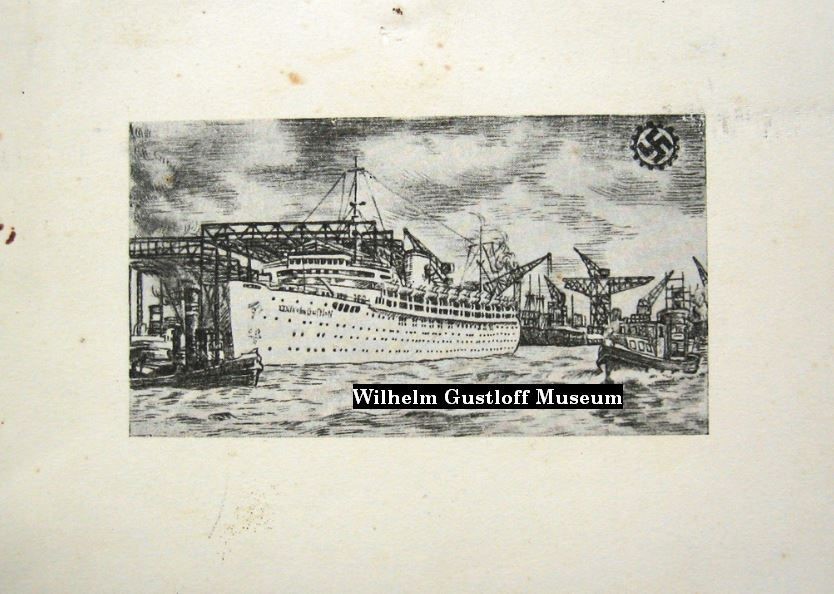
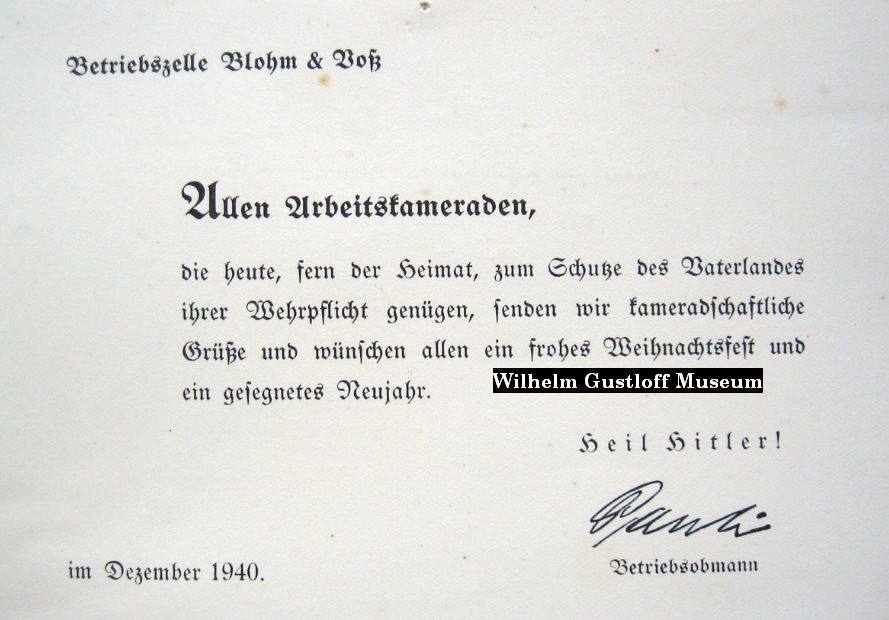
A Christmas card sent to the workers at Blohm & Voss in December of 1940 featuring the Wilhelm Gustloff on the front.
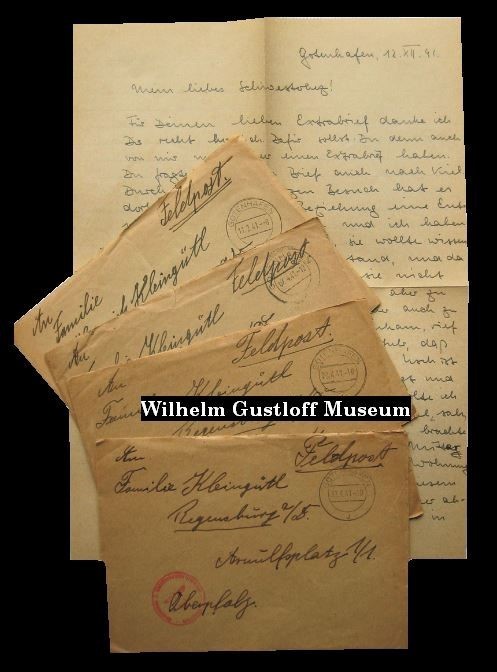


Left: A stack of letters written onboard the Wilhelm Gustloff from February 11th to April 30th, 1941. In one, the sailor thanked his mother for a package and told her all was fine on board.
Above: The back return addresses of the envelopes.
Right: A letter sent from the Wilhelm Gustloff on December 13th, 1941.
Thanks to Werner Hinke for translating these letters.
Above: The back return addresses of the envelopes.
Right: A letter sent from the Wilhelm Gustloff on December 13th, 1941.
Thanks to Werner Hinke for translating these letters.
2 U.L.D. Accommodation Ship - Wilhelm Gustloff 1942 to 1943
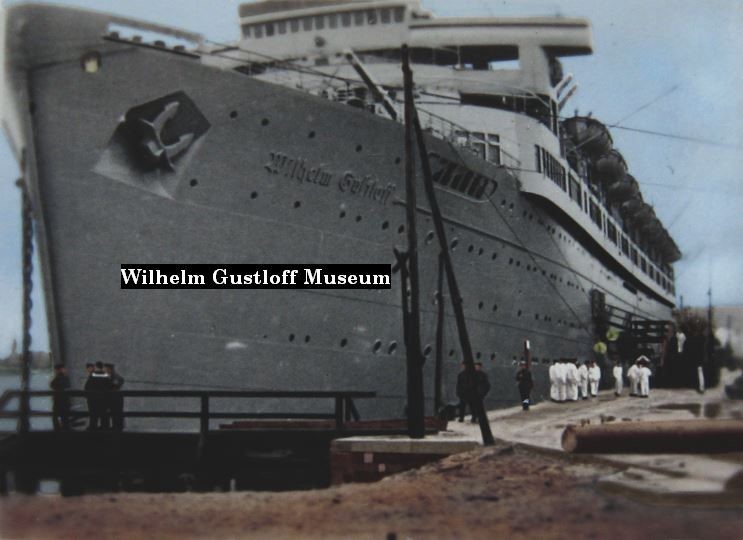
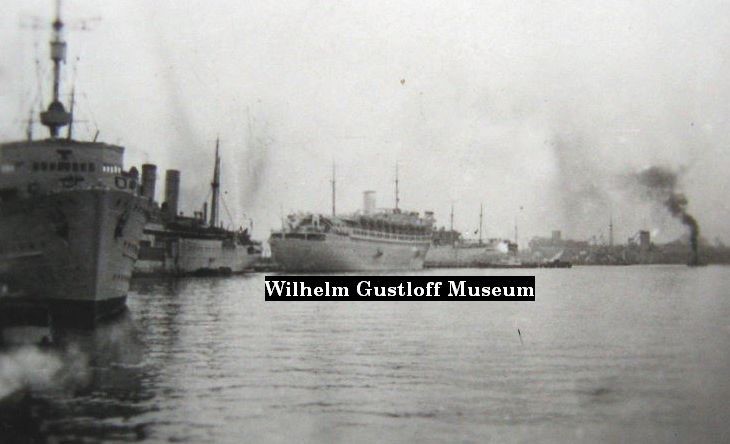
As 1941 comes to a close, the tides of war will start turning away from the side of Germany and its Third Reich. Photographs of the Wilhelm Gustloff become fewer and fewer by 1943, leaving much speculation as to the various events that occurred. There are a few notable events which happened during this time but until more information becomes available, I'm afraid my next paragraph is speculation based on the evidence that I currently have through my research. Current "knowledge" about the Gustloff states she was painted gray once and remained so until 1945, but I've discovered this is not true. After she was painted in 1941, the paint was faded and worn within a year. A likely scenario based on photographs of her being painted during her cruises a number of times. It turns out she was painted a second time around the spring of 1943. In addition to her new coat of paint, this is the time when her lifeboats are being removed from the stern for various training purposes around Gotenhafen. She also receives her large wooden look-out or compass platforms on the bridge and stern Sun Deck - likely for use during training on the deck and in the surrounding water. These are all completed by July of 1943 and in time for the Japanese delegation to visit the Gustloff in September of that year. It is also notable that Admiral Karl Dönitz officially visits Gotenhafen in March of 1943. In the photo below right, you an see the Submarine Tender Saar on the left, followed by the Oceana, Wilhelm Gustloff, Hansa, and what may very well be the silhouette of the Robert Ley. I have always heard that the Ley was docked in Gotenhafen, but there are no known photographs of her there. This could be the only one showing her berthed on the piers just outside the harbor. In the lower left photo, you can also see the "anti-mine" strip begin on her hull at the end of her name between A and B Decks.
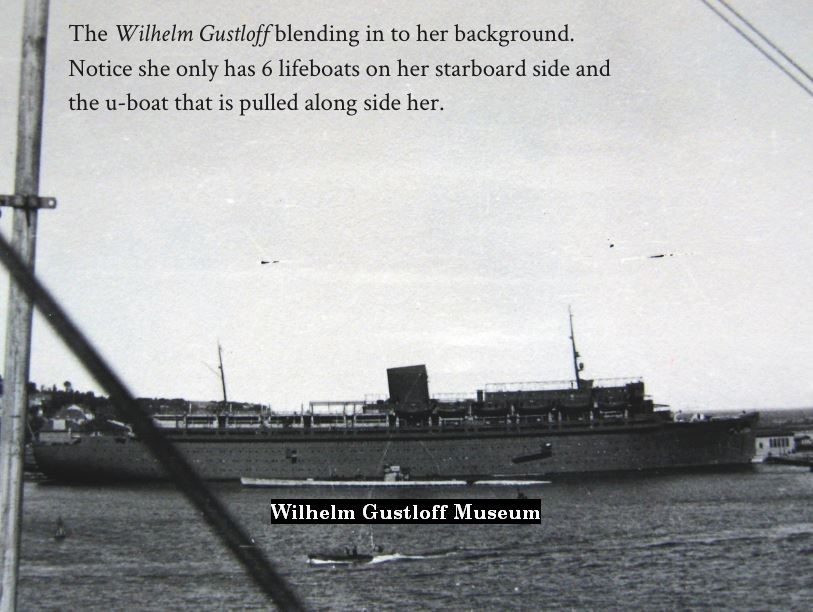
Additional photographs from 1943 or c1943.
Photo #1: The Wilhelm Gustloff.
Photo #2: 2.U.L.D. Officer on board theWilhelm Gustloff Dated: April 4th, 1943.
Photo #3: A DRK (German Red Cross) nurse stationed on the Wilhelm Gustloff. Gotenhafen, July, 1943.
Photo #4: General Admiral Hans Georg von Friedeburg, the Commanding Admiral of the u-boats on board the Wilhelm Gustloff. During a party with other commanders of the u-boat fleet and sailors in the Wilhelm Gustloff's dining hall exchanging gifts and camaraderie.
Photo #5: On board the Wilhelm Gustloff - 2.U.L.D. Gotenhafen March 28th, 1943.
Photo #6: Sailors exit the 'Willi G' through her B Deck boarding doors. Note the checkpoint to get on board on the dockside.
Photo #7 & 8: Two different views of the Monte Rosa in her naval gray paint.
Photo #9 & 10: Additional photos with Admiral Hans Georg von Friedeburg and other officers aboard the ship.
Photo #11: The Gustloff & Hansa. I have the same photo with a u-boat passing in front as well.
Photo #1: The Wilhelm Gustloff.
Photo #2: 2.U.L.D. Officer on board theWilhelm Gustloff Dated: April 4th, 1943.
Photo #3: A DRK (German Red Cross) nurse stationed on the Wilhelm Gustloff. Gotenhafen, July, 1943.
Photo #4: General Admiral Hans Georg von Friedeburg, the Commanding Admiral of the u-boats on board the Wilhelm Gustloff. During a party with other commanders of the u-boat fleet and sailors in the Wilhelm Gustloff's dining hall exchanging gifts and camaraderie.
Photo #5: On board the Wilhelm Gustloff - 2.U.L.D. Gotenhafen March 28th, 1943.
Photo #6: Sailors exit the 'Willi G' through her B Deck boarding doors. Note the checkpoint to get on board on the dockside.
Photo #7 & 8: Two different views of the Monte Rosa in her naval gray paint.
Photo #9 & 10: Additional photos with Admiral Hans Georg von Friedeburg and other officers aboard the ship.
Photo #11: The Gustloff & Hansa. I have the same photo with a u-boat passing in front as well.
October 9th, 1943 -
The Bombing of Gotenhafen Harbor
The Bombing of Gotenhafen Harbor
During 1943, the U.S. Air Force had been taking aerial reconnaissance photos of Gotenhafen. On October 9th, American bombers from the 8th Air Force take off from England and reach the harbor, dropping several bombs over high priority targets, namely the large ships docked here. According to the Gustloff's Chief Engineer Franz Zobel, a stray bomb not listed on the Air Force's official map exploded off the ship's starboard side tearing a 1.5 meter gash in the ship's hull. While the gash was repairable, it slightly bent her starboard propeller shaft.
The ship listed as #1, Liner DEUTSCHLAND type is in fact the Hansa which had a close call of her own. The Wilhelm Gustloff is barely visible in the top left corner. Other ships were not so lucky in the attack. The worst damage happened to the former luxury liner Stuttgart. Loaded with wounded soldiers since she was still classified as Lazarettschiff 'C', she was hit several times and set immediately ablaze killing most onboard in a firestorm. The ship was towed from her berth out in the harbor where she sank to the bottom with the trapped and dead still inside. The Cap Arcona, which finished up filming the German version of Titanic, escaped intact. She would be sunk later with upwards of 5,000 prisoners on May 3rd, 1945. Image: https://www.b24.net/MM100943.htm
The ship listed as #1, Liner DEUTSCHLAND type is in fact the Hansa which had a close call of her own. The Wilhelm Gustloff is barely visible in the top left corner. Other ships were not so lucky in the attack. The worst damage happened to the former luxury liner Stuttgart. Loaded with wounded soldiers since she was still classified as Lazarettschiff 'C', she was hit several times and set immediately ablaze killing most onboard in a firestorm. The ship was towed from her berth out in the harbor where she sank to the bottom with the trapped and dead still inside. The Cap Arcona, which finished up filming the German version of Titanic, escaped intact. She would be sunk later with upwards of 5,000 prisoners on May 3rd, 1945. Image: https://www.b24.net/MM100943.htm
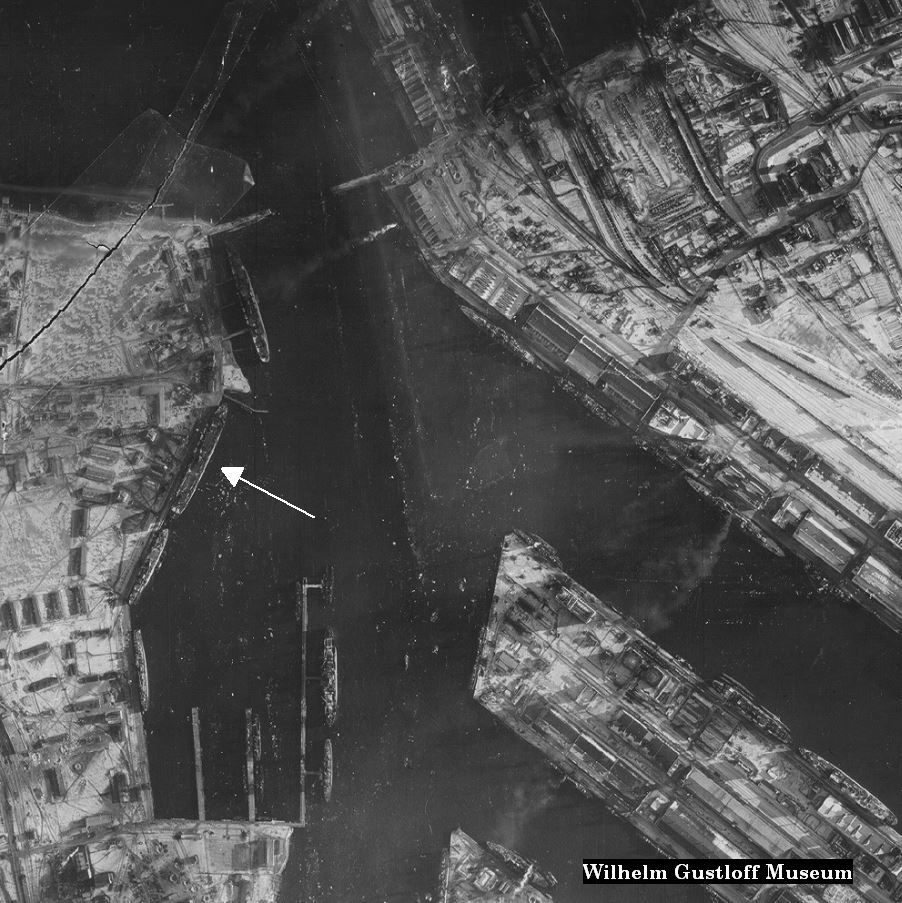
2 U.L.D. Accommodation Ship - Wilhelm Gustloff 1944
The Wilhelm Gustloff survived her first attack as the situation for Germany slowly began to deteriorate. February 22nd, 1944 marks the return of Friedrich Petersen as captain. Captain Bertram gets his wish to be back at sea with a "ship that moves" and is to report back to Hamburg on the 21st. Petersen has been through quite an ordeal since commanding the Gustloff for just one cruise during peacetime. He had been captured by the Allies and was held as a POW. Repatriated to the Germans because of his age, at 66 years old he not considered a threat. He gains freedom in return for a written promise not to take active command of any ship. The Gustloff must seem like the perfect option. By this time however, front lines continue to disintegrate. Official press releases struggle to find any form of victory. Fewer u-boats return from missions. The Soviets were pushing back on the Eastern Front and the Afrika Corps were defeated in Egypt. In just 6 months, the D-Day landings in France would be a major blow to Hitler and his Third Reich. Although Danzig still stands, there is a troubled uneasy feeling over the bay as the Russians drive nearer by the day. Refugees begin heading toward the ports in the Gulf to escape Russian retribution. By October of 1944, the Red Army under the command of General Galitsky is crossing the eastern border of the Reich and taking the town of Nemmersdorf in East Prussia - the first German city to fall into Russian hands. Terror is only the beginning in the Gulf of Danzig. The RAF also completes another bombing raid over Gotenhafen on December 18th & 19th, 1944.
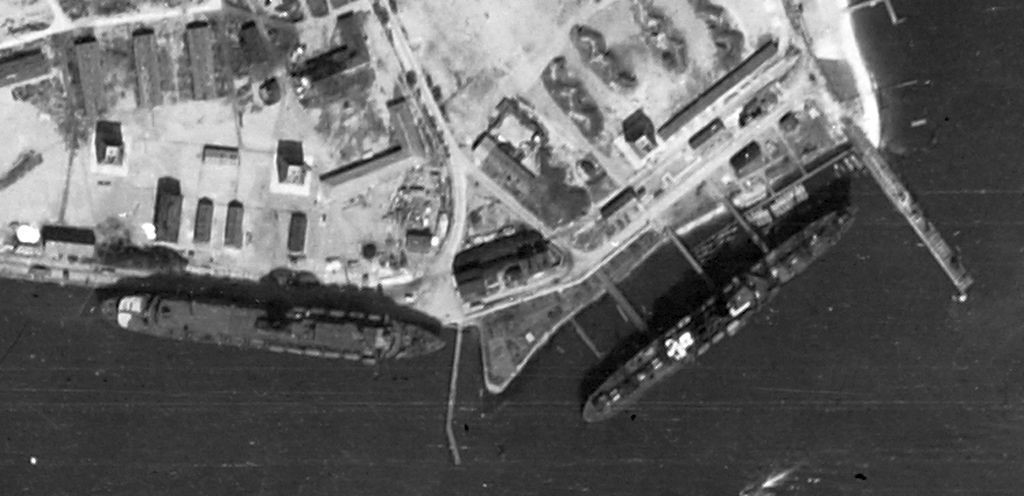
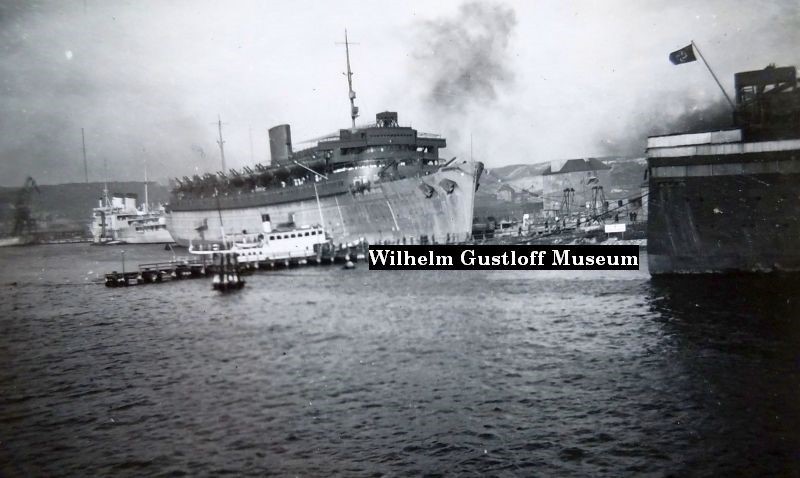
Another photo album in the collection belonged to a crew member of the 1937 German built training tall ship Albert Leo Schlageter (NRP Sagres).
Several of his photos show time aboard, including the damage the ship took when hitting a mine on November 14th, 1944. The ship was towed by
the Horst Wessel(USCG Eagle) to Swinemunde, and after a damage photo was taken, the photographs switch to Gotenhafen, where he takes the
three pictures. Right:One includes the Cap Arcona in her wartime gray, another the Admiral Hipper across the way with the auxiliary cruiser Hansa
behind her.
Then there is the photograph of the Wilhelm Gustloff in the process of her refit in mid 1944 below. Among the "upgrades" included were:
- The liner received a new coat of dark gray paint. This photo shows the decks from the Lower Promenade upward have been painted already.
- The bridge windows were reinforced and made smaller - assumingly to protect against enemy fire and explosions. Another photograph (below middle inset) shows a sailor making the tight squeeze into the Wilhelm Gustloff's forward ventilator on the bow surrounded by a group of friends during the refit. Notice the planks on the Upper Promenade Deck and the additional scaffolding that has been added around the bridge on the Sun Deck showing the bridge windows being reinforced. The finished product is evident in the finished picture.
- Extended anti-aircraft lookout platforms were painted gray above the bridge and on the stern end of the Sun Deck.
- The white section on her stern is the addition of 30 inflatable rafts sitting on the rear of the Lower Promenade Deck. She has more added before being placed back in her berth above, but loses several by December. These can clearly be seen in the above thumbnail on her deck.
- In January 1945, additional lifeboats, rafts, and other flotation devices would be stockpiled aboard. The Gustloff would only wear this new outfit for 5 months before being sunk.
Several of his photos show time aboard, including the damage the ship took when hitting a mine on November 14th, 1944. The ship was towed by
the Horst Wessel(USCG Eagle) to Swinemunde, and after a damage photo was taken, the photographs switch to Gotenhafen, where he takes the
three pictures. Right:One includes the Cap Arcona in her wartime gray, another the Admiral Hipper across the way with the auxiliary cruiser Hansa
behind her.
Then there is the photograph of the Wilhelm Gustloff in the process of her refit in mid 1944 below. Among the "upgrades" included were:
- The liner received a new coat of dark gray paint. This photo shows the decks from the Lower Promenade upward have been painted already.
- The bridge windows were reinforced and made smaller - assumingly to protect against enemy fire and explosions. Another photograph (below middle inset) shows a sailor making the tight squeeze into the Wilhelm Gustloff's forward ventilator on the bow surrounded by a group of friends during the refit. Notice the planks on the Upper Promenade Deck and the additional scaffolding that has been added around the bridge on the Sun Deck showing the bridge windows being reinforced. The finished product is evident in the finished picture.
- Extended anti-aircraft lookout platforms were painted gray above the bridge and on the stern end of the Sun Deck.
- The white section on her stern is the addition of 30 inflatable rafts sitting on the rear of the Lower Promenade Deck. She has more added before being placed back in her berth above, but loses several by December. These can clearly be seen in the above thumbnail on her deck.
- In January 1945, additional lifeboats, rafts, and other flotation devices would be stockpiled aboard. The Gustloff would only wear this new outfit for 5 months before being sunk.
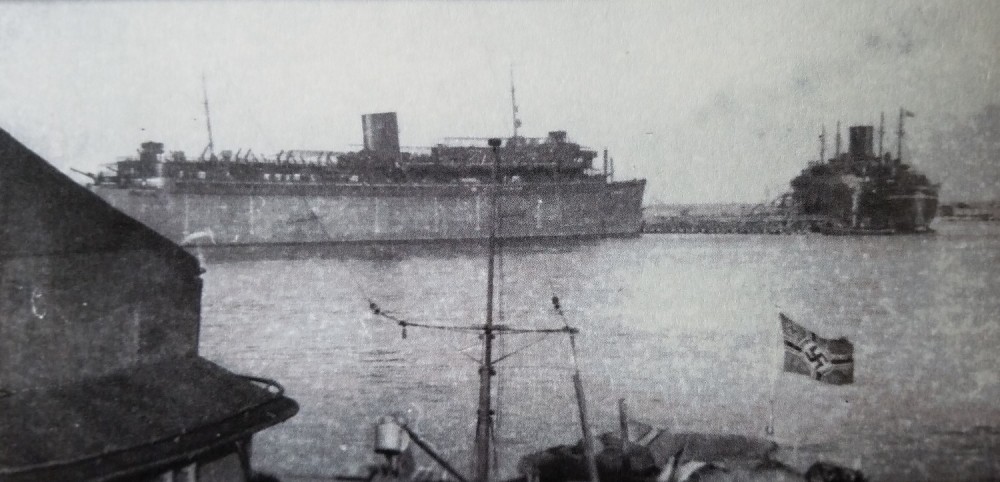
The Wilhelm Gustloff in Gotenhafen. With the addition of the platforms, this image dates from September 1944 to January 1945 - though it is generally said to have been taken in January.
Sammlung Jörg-M. Hormann Collection.
Sammlung Jörg-M. Hormann Collection.
The Wilhelm Gustloff's August 1944 Refit
Imperial Japanese Navy Visit to Gotenhafen
September, 1943
September, 1943
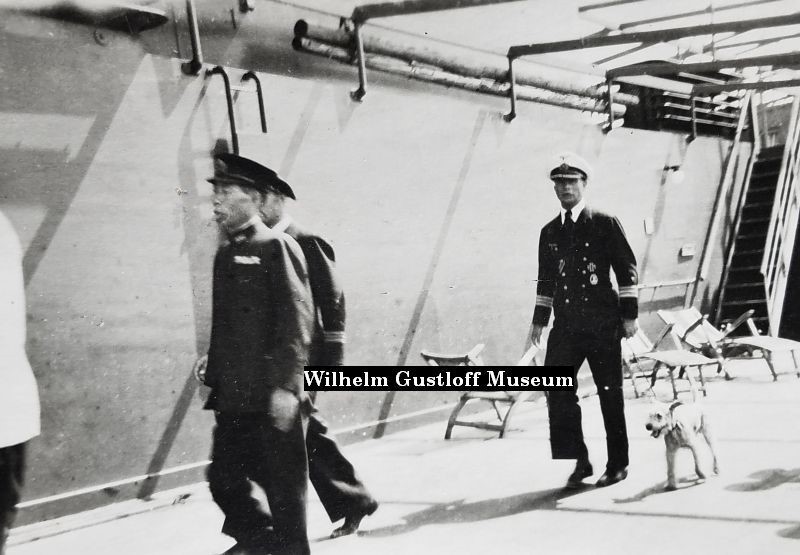
Image courtesy of Festningsverk.no.
The Wilhelm Gustloff's Spring 1943 Refit
In the April or May of 1943, the Wilhelm Gustloff receives a few upgrades. The first image below shows her second coat of paint being applied. Close examination of the photo shows her lighter areas are in fact already a faded gray with a darker gray already on the funnel and most of the hull, including the forward superstructure above the bow. This is the time when she also begins to lose her stern lifeboats - 4 on her starboard side are already missing. These were used in various activities around the harbor and for training. The second photo below shows her new darker paint job already completed with a U-boat along side the liner. She is missing another lifeboat by this point. Shortly after these were taken, she also had two large wooden anti-aircraft lookout platforms built on her bridge and stern Sun Deck. All of this work was completed by July.
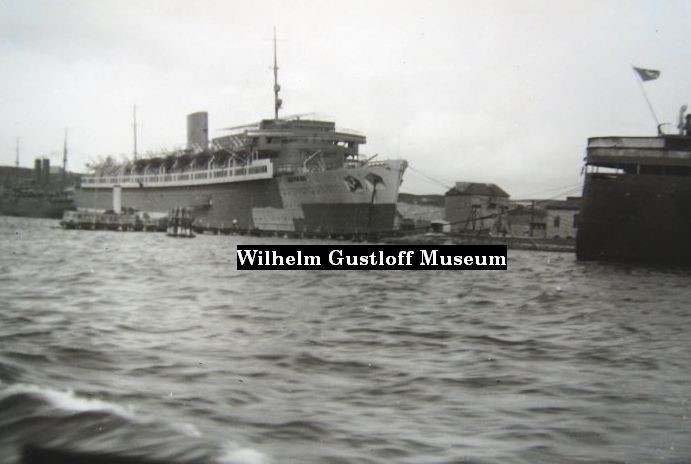

By 1944, there are only a handful of Wilhelm Gustloff photographs that are known to have been taken. With the Third Reich falling apart, documenting the big ships in Gotenhafen, Danzig, and Pillau isn't as common as it once was. Two such pictures to surface are shown here. Historically, this is very important photograph because is shows us that the liner was repainted a third time and outfitted with reinforced bridge windows - something not known. Her large bridge platform is very clear in this image, as well as a platform rising up on the stern of the Hansa. The ship in the background is believed to be the Vega.
Below 3rd is a photo of Werner Viehs (born 1924) from Bad Homburg aboard the Gustloff in 1944. Werner talks about his time here aboard the Wilhelm Gustloff in 1944 and how he trained not only on the ship, but on the Robert Ley and Cap Arcona.
"The Wilhelm Gustloff was better maintained than the Robert Ley. Maybe it's an unauthorized, subjective opinion. On the Wilhelm Gustloff, I was accommodated on the better Upper Promenade Deck and here on the Robert Ley on the land side in the A Deck. On the ships were our living and dining rooms. Here we did training and dry exercises. There were three submarines for our practice." Image & story courtesy of the Deutsches Historiches Museum.
Below 4th is a photo taken in Gotenhafen of the ships at dock. Based on the appearance of the Gustloff, this was taken between August 1944 and January 1945.
Below 3rd is a photo of Werner Viehs (born 1924) from Bad Homburg aboard the Gustloff in 1944. Werner talks about his time here aboard the Wilhelm Gustloff in 1944 and how he trained not only on the ship, but on the Robert Ley and Cap Arcona.
"The Wilhelm Gustloff was better maintained than the Robert Ley. Maybe it's an unauthorized, subjective opinion. On the Wilhelm Gustloff, I was accommodated on the better Upper Promenade Deck and here on the Robert Ley on the land side in the A Deck. On the ships were our living and dining rooms. Here we did training and dry exercises. There were three submarines for our practice." Image & story courtesy of the Deutsches Historiches Museum.
Below 4th is a photo taken in Gotenhafen of the ships at dock. Based on the appearance of the Gustloff, this was taken between August 1944 and January 1945.
Young recruits and sailors arrive in Gotenhafen to begin their training aboard the Wilhelm Gustloff. Training consisted of:
a.) Solidification and review of past learning; e.g. Morse, blinking, signaling. Maritime activities, Working with a pulling cutter, u. s. w.
b.) Exercises on simultaneous systems, (central, diving bell).
a.) Solidification and review of past learning; e.g. Morse, blinking, signaling. Maritime activities, Working with a pulling cutter, u. s. w.
b.) Exercises on simultaneous systems, (central, diving bell).
c.) Practical handling in the Baltic Sea with submarines and torpedoes.
d.) Ensign preparatory course then took place on the Cap Arcona with topics of position and behavior of an officer. Task, duty, competence, etc.
Further training at the 1st U-boat teaching division on the Robert Ley in Pillau was similar, but not so extensive and intense.
d.) Ensign preparatory course then took place on the Cap Arcona with topics of position and behavior of an officer. Task, duty, competence, etc.
Further training at the 1st U-boat teaching division on the Robert Ley in Pillau was similar, but not so extensive and intense.
Aerial view of Gotenhafen - December 21st, 1944
Taken just a little over a month before her sinking, this RAF photo shows the Wilhelm Gustloff, Hansa, and Oceana at their piers in Gotenhafen.
Below is the image I have and it shows lifesaving rafts grouped on her stern Lower Promenade Deck and one on either side of the Upper Promenade Deck near the end of that deck. It is unclear if her anti-aircraft guns have been added at this point, though they are believed to have been added in the 5 days prior to departure.
Taken just a little over a month before her sinking, this RAF photo shows the Wilhelm Gustloff, Hansa, and Oceana at their piers in Gotenhafen.
Below is the image I have and it shows lifesaving rafts grouped on her stern Lower Promenade Deck and one on either side of the Upper Promenade Deck near the end of that deck. It is unclear if her anti-aircraft guns have been added at this point, though they are believed to have been added in the 5 days prior to departure.

On November 9th, plans were made for the construction, redesign, and removal of bomb damage from the raid. The marine manager signed off on plans for:
- Map showing the location of bomb damage and Oxhöft building damage.
- Simplified construction for the elimination of bomb damage in Oxhöft.
- Drawing for Base III format.
- Technical drawings for Base III.
- Drawing of pier damages dated November 12, 1944.
Other plans are likely out there, but these are ones I found the records for. I managed to purchase a copy of these plans from Germany, but they were lost in the mail and never arrived. I only have one image from the set to survive shown below.
Below Right: I was able to purchase a large reconnaissance photograph from October 10th, 1943 - the day after the bombing. It shows the various target hits and ships in the harbor at the time. With the assistance of those online, I attempted to identify as many ships as possible.
- Map showing the location of bomb damage and Oxhöft building damage.
- Simplified construction for the elimination of bomb damage in Oxhöft.
- Drawing for Base III format.
- Technical drawings for Base III.
- Drawing of pier damages dated November 12, 1944.
Other plans are likely out there, but these are ones I found the records for. I managed to purchase a copy of these plans from Germany, but they were lost in the mail and never arrived. I only have one image from the set to survive shown below.
Below Right: I was able to purchase a large reconnaissance photograph from October 10th, 1943 - the day after the bombing. It shows the various target hits and ships in the harbor at the time. With the assistance of those online, I attempted to identify as many ships as possible.
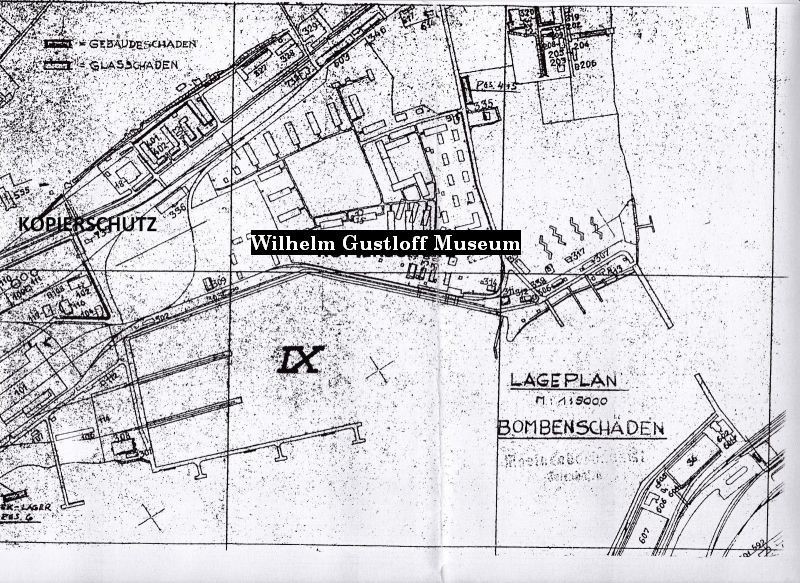
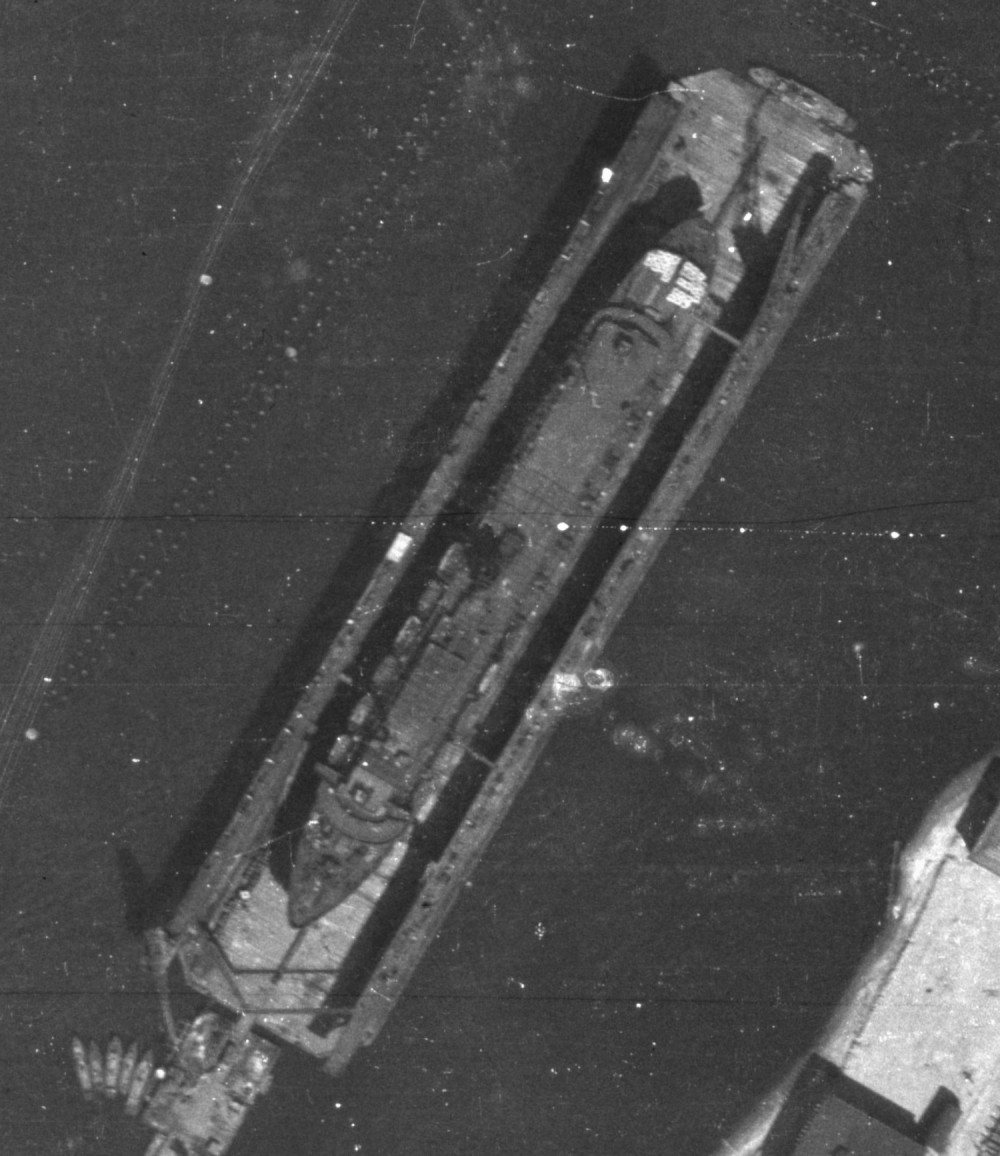
In the summer of 1944, the Wilhelm Gustloff would receive her third and final refit of the war. Until recently, most who wrote about the Gustloff assumed she stayed at her berth from 1940 to 1945. One even writing about the difficulty of moving her away from the dock because of the mud caked up along her hull. If there is something I love about history, it is that evidence always changes our what we know about various events. There is a little known fact that she was moved and dry-docked just 5 months before she met her infamous fate. It is not known if she was moved under her own steam or by tug, but the latter seems the most plausible.
On August 7th, 1944, an airplane took the photo (below left) of the Wilhelm Gustloff in a dry dock situated further inland at Gotenhafen. By August 23rd, a later photo shows her (below) berthed back at her pier with the Hansa. After plans were carried out for the repair of the docks after the bombing nearly a year earlier, it is likely the Kriegsmarine took turns drydocking ships to repair and check for damage. The plans were dated well into 1944, so the reconstruction work was still known to have been going on. This would have given them time to check on her bent propeller shaft or properly repairing her 1.5 meter gash that may have had a quick fix applied to it prior.
Based on what was being done to the ship above the waterline, it was likely known she would play a more dangerous role in the war as the Red Army moved in. She is still missing several of her life boats, retaining 11 of her original 22. Both photos purchased from & courtesy of: National Collection of Aerial Photography. http://ncap.org.uk/
On August 7th, 1944, an airplane took the photo (below left) of the Wilhelm Gustloff in a dry dock situated further inland at Gotenhafen. By August 23rd, a later photo shows her (below) berthed back at her pier with the Hansa. After plans were carried out for the repair of the docks after the bombing nearly a year earlier, it is likely the Kriegsmarine took turns drydocking ships to repair and check for damage. The plans were dated well into 1944, so the reconstruction work was still known to have been going on. This would have given them time to check on her bent propeller shaft or properly repairing her 1.5 meter gash that may have had a quick fix applied to it prior.
Based on what was being done to the ship above the waterline, it was likely known she would play a more dangerous role in the war as the Red Army moved in. She is still missing several of her life boats, retaining 11 of her original 22. Both photos purchased from & courtesy of: National Collection of Aerial Photography. http://ncap.org.uk/
Wilhelm Gustloff Museum
National Collection of Aerial Photography
August 7th, 1944.
National Collection of Aerial Photography
August 7th, 1944.
Wilhelm Gustloff Museum
National Collection of Aerial Photography
August 23rd, 1944.
National Collection of Aerial Photography
August 23rd, 1944.
Left: Thumbnails of original purchased photographs and close-up of the life rafts on the Wilhelm Gustloff's stern in drydock.
Admiral Karl Dönitz visits the
Wilhelm Gustloff in Gotenhafen
March, 1943
Wilhelm Gustloff in Gotenhafen
March, 1943
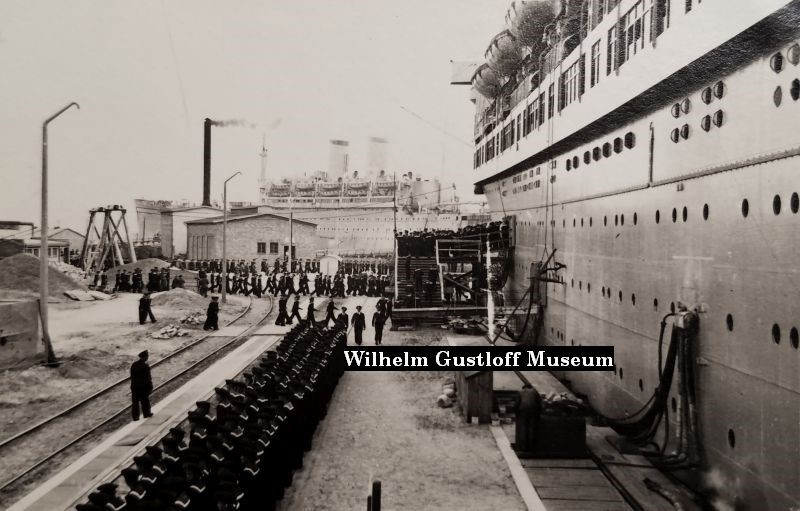
In March of 1943, Admiral Karl Donitz makes an official visit to Gotenhafen to see the submariners and their commanders, including Korv. Kapt. Hashagen of the 2. U.L.D. The Kriegsmarine goes all out in making their Admiral feel most welcome, with hundreds, if not thousands of sailors parading around Gotenhafen and aboard the Wilhelm Gustloff.
Some of these photos were reproduced in several other albums and are now known to have come from this event. The photographer even took two snapshots in his cabin of his living arrangements.
Perhaps the best photograph of the lot is shown on the right. With the Hansa in the background, the Gustloff is tied up at her berth in naval gray. This is the clearest image that I've seen that shows her degaussing (anti-mine) cable strung between A and B Decks. It also shows how she was hooked up to the port for electricity. The black cables and pipes are funneling into her oil takeover doors on C Deck, which feed into the funnel shaft and down to the engine room.
This set offers some very unique shots of the ship that I haven't seen anywhere else, as most photographs are taken from the water and capturing her starboard side. The only thing that would've made this set better is to have the album in its entirety. Unfortunately, these were ripped out of the original album and sold individually for profit rather than being kept together as they should've been.
Some of these photos were reproduced in several other albums and are now known to have come from this event. The photographer even took two snapshots in his cabin of his living arrangements.
Perhaps the best photograph of the lot is shown on the right. With the Hansa in the background, the Gustloff is tied up at her berth in naval gray. This is the clearest image that I've seen that shows her degaussing (anti-mine) cable strung between A and B Decks. It also shows how she was hooked up to the port for electricity. The black cables and pipes are funneling into her oil takeover doors on C Deck, which feed into the funnel shaft and down to the engine room.
This set offers some very unique shots of the ship that I haven't seen anywhere else, as most photographs are taken from the water and capturing her starboard side. The only thing that would've made this set better is to have the album in its entirety. Unfortunately, these were ripped out of the original album and sold individually for profit rather than being kept together as they should've been.
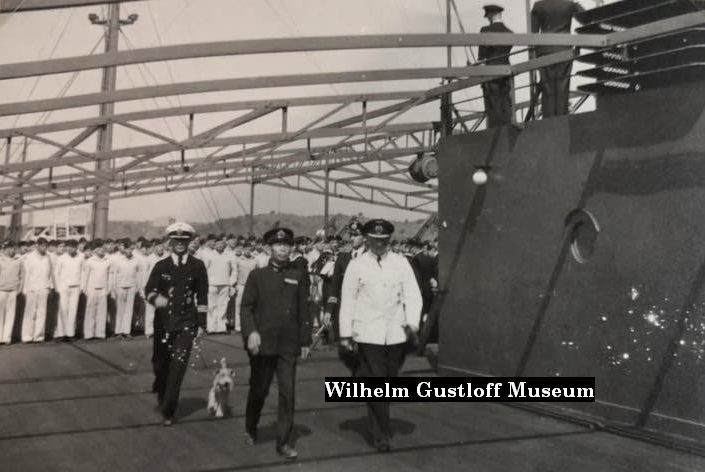
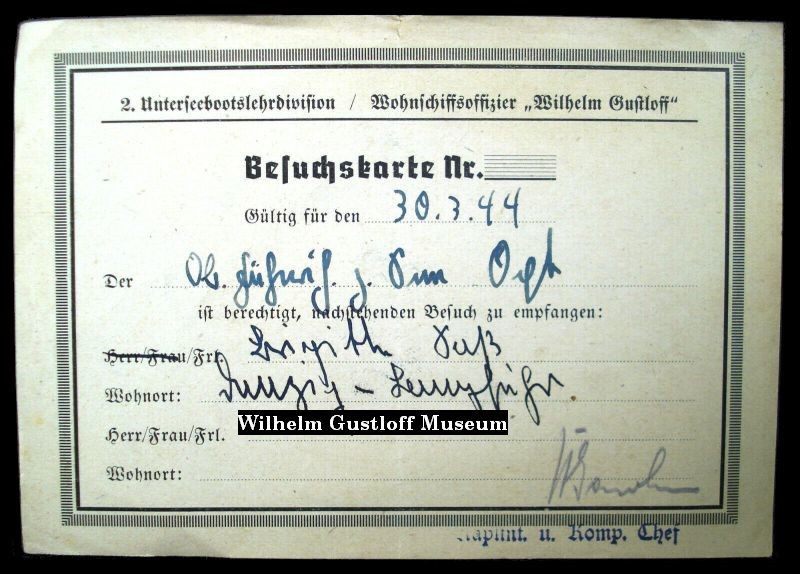
Visitor's Pass for the Wilhelm Gustloff while in Gotenhafen
2. Submarine Division / Residental Ship Officer "Wilhelm Gustloff"
Visitor's Card Number:
Valid for March 30th, 1944
He is entitled to receive the following visit:
Mr./Mrs./Miss
Place of Residence
Signed Kapant. u. Komp. Chef.
2. Submarine Division / Residental Ship Officer "Wilhelm Gustloff"
Visitor's Card Number:
Valid for March 30th, 1944
He is entitled to receive the following visit:
Mr./Mrs./Miss
Place of Residence
Signed Kapant. u. Komp. Chef.
The above 5 photographs came in a collection featuring the Wilhelm Gustloff, Hansa, Cap Arcona, a wide shot of Gotenhafen's outer piers with several ships, and two photographs aboard the Antonio Delfino.
Monte Pascoal in camouflage.
Left: Group picture of young sailors of the 2nd U.L.D. Gotenhafen in a lounge aboard Wilhelm Gustloff, 1942. The photo includes Ludwig Bierl, later a crewmember of the U-744, which was sunk on March 6, 1944.
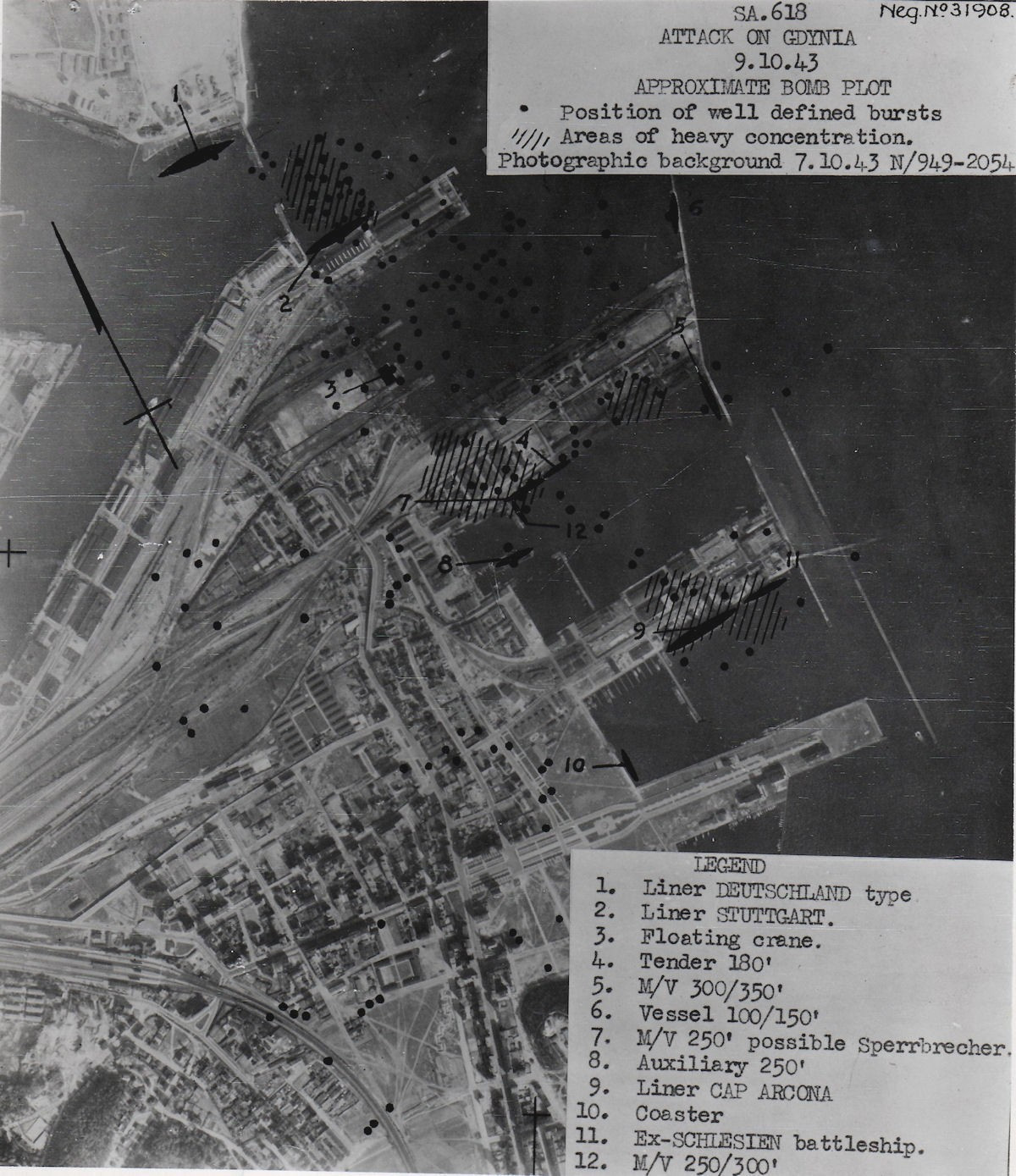
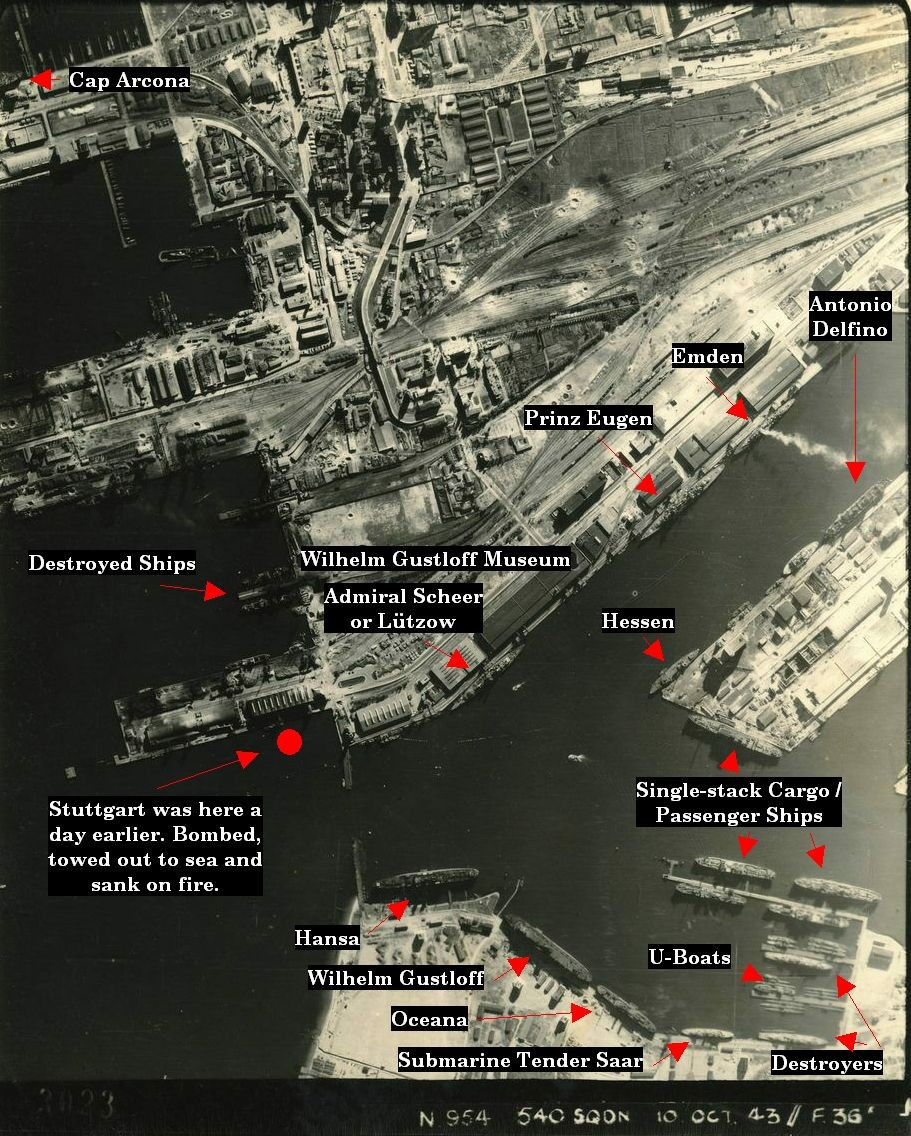
Aboard the Prinz Eugen,
April 30th, 1944.
The Wilhelm Gustloff can be seen in the background.
April 30th, 1944.
The Wilhelm Gustloff can be seen in the background.
Four photos aboard the Wilhelm Gustloff, Gotenhafen, March 1944. (right)
#1: 2nd U-Training Division
Platoon leader of 7th company.
#2: 2nd U-Training Division Group leader of 7th company.
(Petty officer 2nd class Lux)
#3: 7. 2nd U-Training Division, The leaders of the 3rd/4th/1st platoon.
#3: 7. 2nd U-Training Division, The leaders of the 3rd/4th/1st platoon.
Staff Sergeant Steiger, Schlooms, Freder.
[I do not know the meaning of 7. There were 4 Training Divisions]
#4: Company leader, Captain lieutenant Voigt and Master Sergeant Wilhelms.
#4: Company leader, Captain lieutenant Voigt and Master Sergeant Wilhelms.
[Kaleun is historical usage for KL=Kapitänleutnant.
I found a register as Alfred Voigt died 30-01-1945 - Likely in the sinking.]
Right: U-Boat School Christmas Party aboard the Wilhelm Gustloff, December 1942.
Right: The Gustloff from the Gotenhafen Barracks. August 1944, The Hansa with the Gustloff hidden behind in Gotenhafen. c1944.
A German death card for Leonhard Ruchti.
My beloved husband, the best father of his children, died a heroic death for his Fatherland after being severely wounded.
Staff Sergeant, Leonhard Ruchti
Born October 31, 1901 in Gundelfingen.
He was seriously wounded in Estonia on October 14, 1944 and died on the transport ship Steuben on October 16, 1944 in Gotenhafen. His comrades took him to be laid to rest.
Photographs of sailors aboard the Wilhelm Gustloff showing their daily life routines from late 1941 to January 25th, 1943. (Photo #15 has this date on the back).
The first photograph is not part of the collection, but found online. It showcases another sailor aboard the Gustloff wearing a life jacket.
The first photograph is not part of the collection, but found online. It showcases another sailor aboard the Gustloff wearing a life jacket.
Slightly out of order, but coming from the same set of photographs are 4 taken aboard the S.S. Hansa. Docked next to the Gustloff, it shows three unique views aboard the liner and one of the Gustloff in the distance. Dated April 2nd, 1943.
A sailor checking his gun aboard the Monte Rosa.
Left 3: Sept / Oct 1941.
Right: Chess aboard the Hansa.
Right: Chess aboard the Hansa.
Left: Monte Olivia in camo. Date unknown.